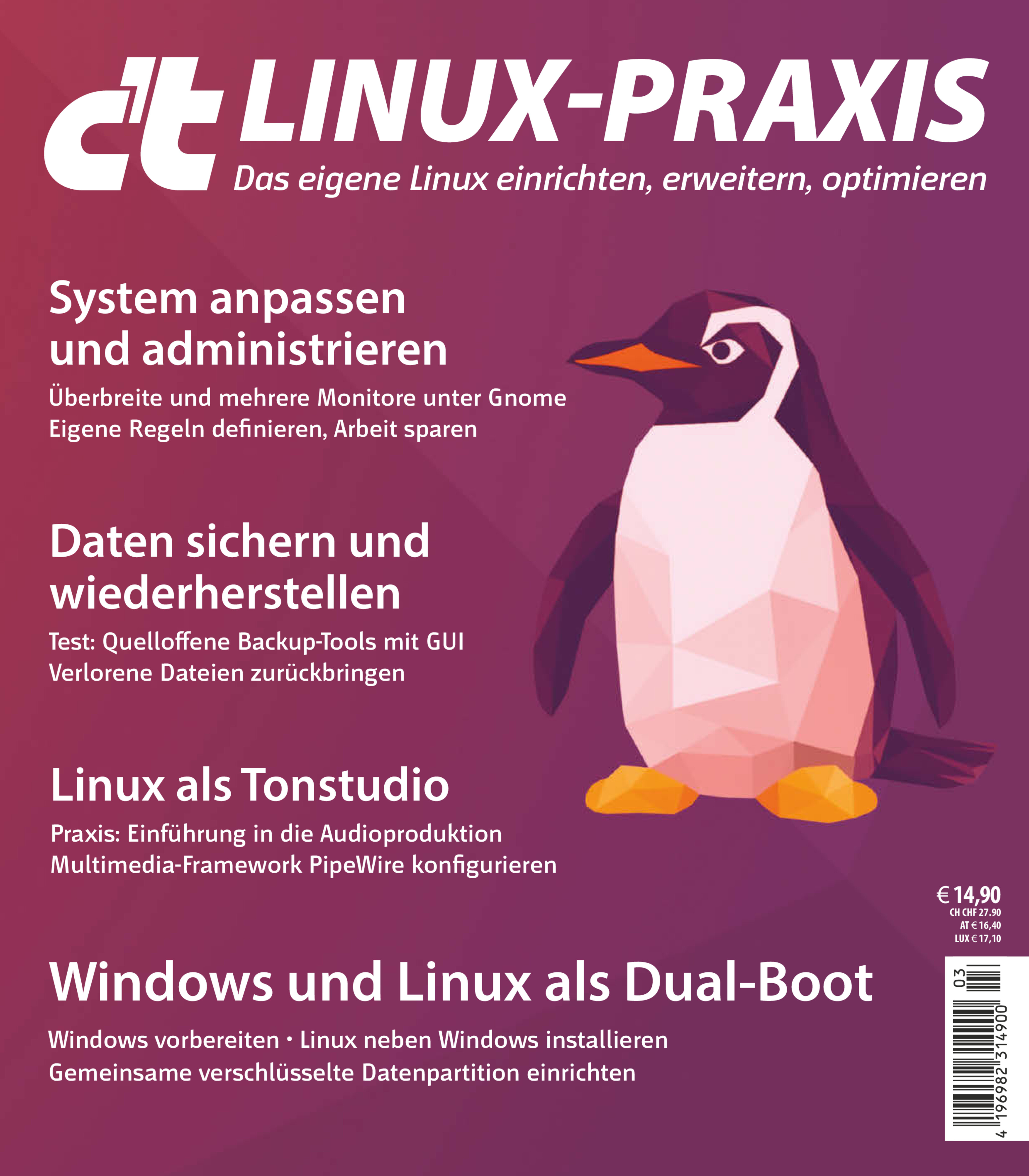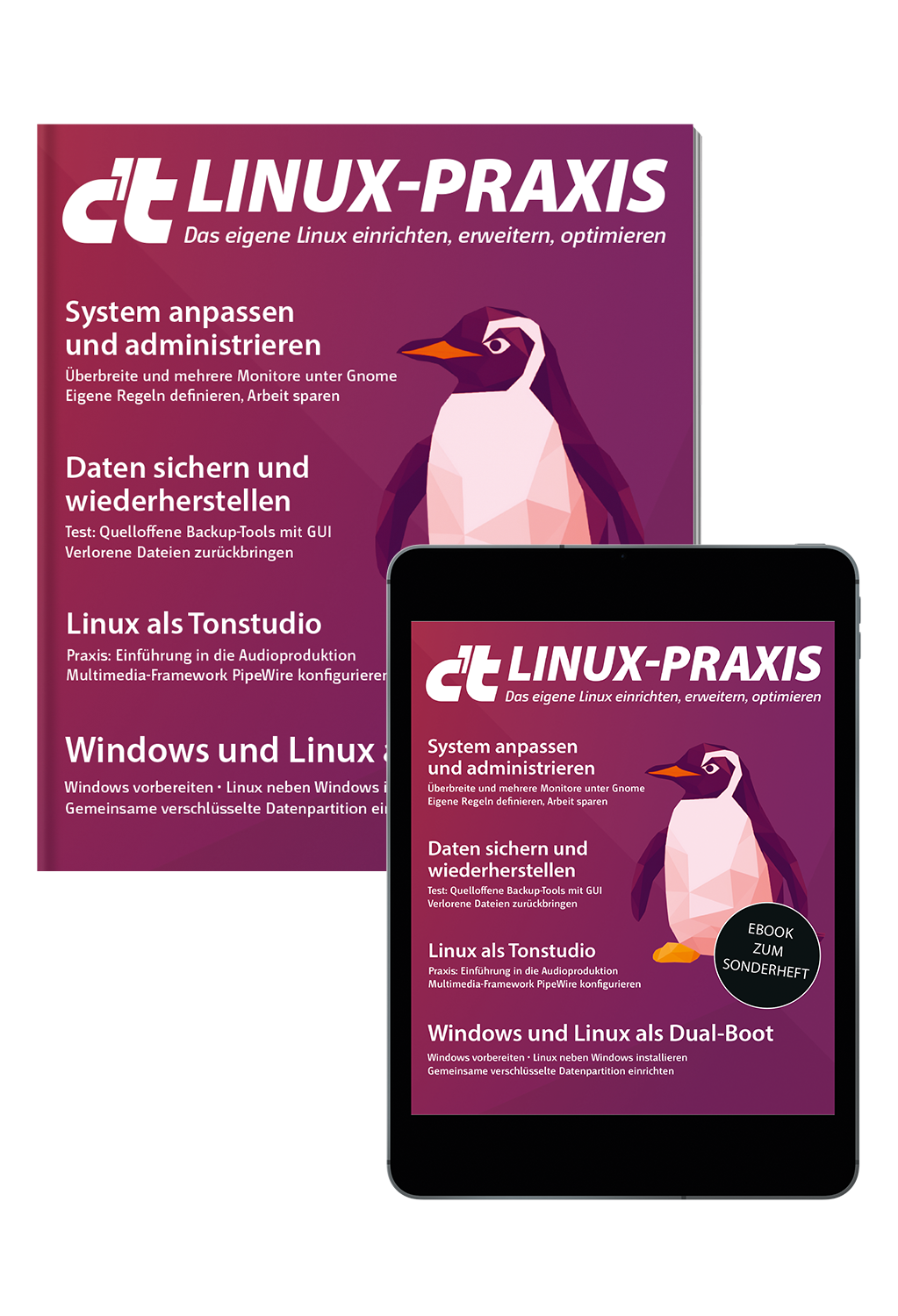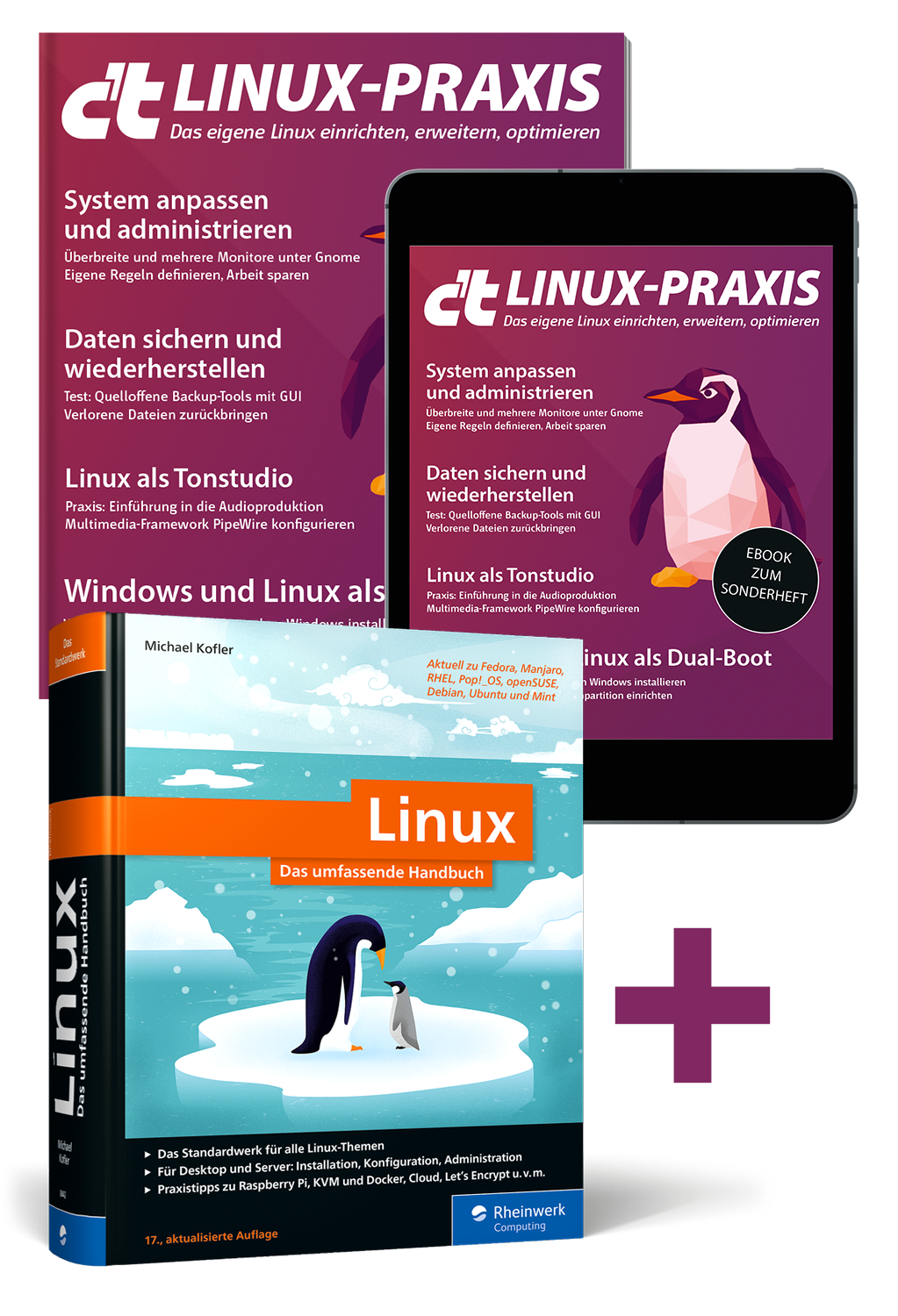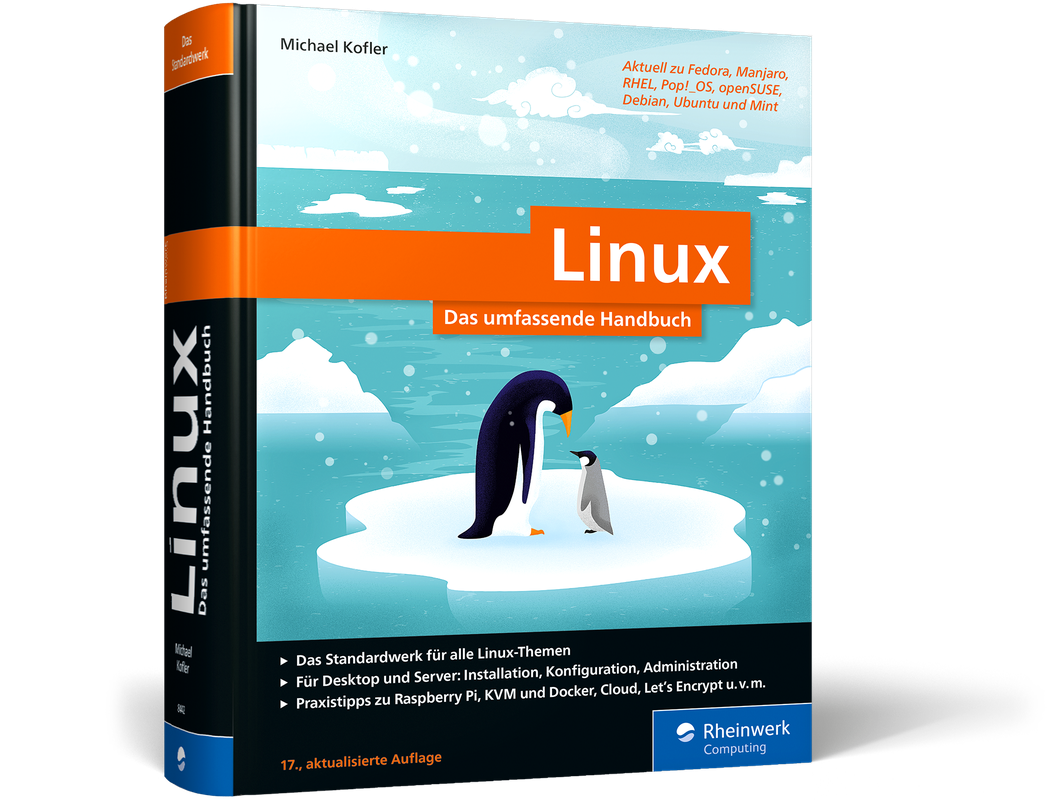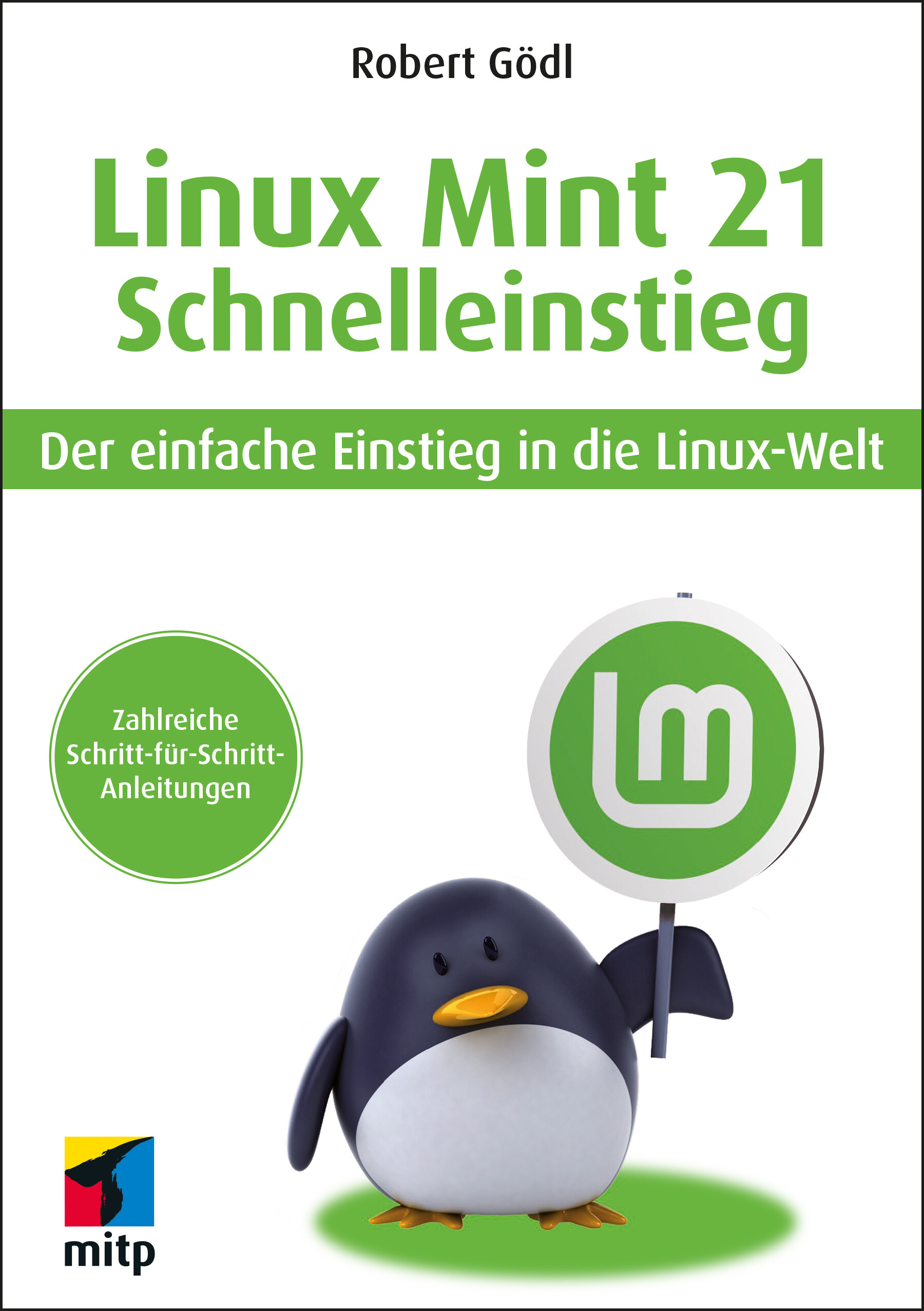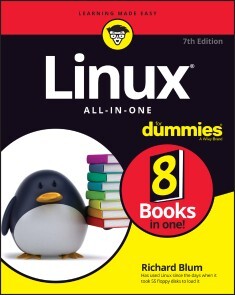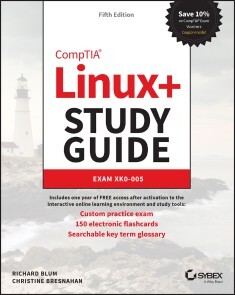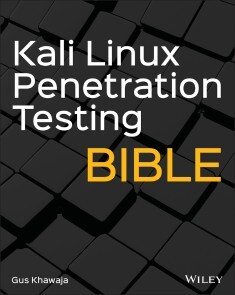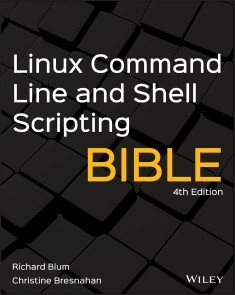
c't Linux-Guide
Linux-User schätzen die vielen Möglichkeiten, das System an ihre Bedürfnisse anzupassen. c’t Linux-Praxis zeigt Ihnen weitere Stellschrauben, die Sie noch nicht gesehen haben. Aber auch für Ein- und Umsteiger, die auf Windows nicht verzichten wollen, zeigt dieses Sonderheft detailliert, wie Sie beide Systeme sicher miteinander verheiraten.
Wenn Sie tiefer in die Linux-Welt einsteigen möchten, haben wir hier für Sie noch einige Fachbücher, eBooks und Videokurse herausgesucht.
c't Linux-Praxis
c't Linux-Praxis
14,90 €*
Linux-User schätzen die vielen Möglichkeiten, das System an ihre Bedürfnisse anzupassen. c’t Linux-Praxis zeigt Ihnen weitere Stellschrauben und noch mehr.
%
Bundle c't Linux-Praxis (Heft + PDF)
19,90 €*
27,89 €*
(28.65% gespart)
Komplett im Set: gedrucktes Heft + digitale Ausgabe mit einer Ersparnis von 7,90 Euro.
Windows und Linux auf einem Rechner
6
Windows oder Linux? Beides!
8
So verkleinern Sie die Windows-Partition
16
Linux verschlüsseln trotz Dual-Boot
22
Gemeinsame sichere Partition einrichten
28
USB-Stick wählt Windows oder Linux
Anzeige unter Gnome optimieren
36
Gnome-Anmeldung: Multimonitor steuern
42
Gnome für große Monitore einrichten
50
Performance-Overlay für Spiele & mehr
Linux als Tonstudio
56
Audioströme bequem umleiten mit PipeWire
62
Einstieg in die freie DAW Ardour
72
Mit WirePlumber Audiogeräte aufräumen
System anpassen und administrieren
76
Mit Udev Zugriffsrechte gewähren
82
Schalten und walten mit NetworkManager
84
Sicher und bequem arbeiten mit SSH
90
Firefox in Ubuntu: APT statt Snap
Daten sichern und wiederherstellen
94
Backup-Programme für den Linux-Desktop
103
Pika-bello
104
Backup-Strategien für Linux-Desktops
108
Daten sichern mit BorgBackup
116
Gelöschte Dateien wiederherstellen
Zum Heft
3
Editorial
107
Impressum
122
Vorschau: c’t Sicher einkaufen
%
Superbundle c't Linux-Praxis (Heft + PDF + Buch)
64,80 €*
77,79 €*
(16.7% gespart)
Mit dem Superbundle sparen Sie 12,99 Euro.
Komplett im Set: gedrucktes Heft + digitale Ausgabe. Enthalten im Angebot ist auch das Buch "Linux - Das umfassende Handbuch“ vom Rheinwerk Verlag im Wert von 49,90 Euro.
Zum Buch:
»Der Kofler«: der Standard in Sachen Linux in der mittlerweile 17. Auflage aus dem September 2021!Ob als Einsteiger oder erfahrener Linuxer – mit diesem Buch bleiben keine Fragen offen. Von der Installation und den verschiedenen Benutzeroberflächen über die Arbeit im Terminal, die Systemkonfiguration und -administration bis hin zum sicheren Einsatz als Server – hier werden Sie fündig! Distributionsunabhängig und natürlich am Puls der Zeit. Aus dem Inhalt: Installation (Debian, Ubuntu, Fedora, Manjaro, openSUSE)Desktops: Gnome, KDE und mehrFotos, Videos und Audio bearbeiten und verwaltenRaspberry PiArbeiten im Terminal: bash, vim, emacsSoftware-/PaketverwaltungGrafiktreiber, Display-SkalierungGRUB2, systemd, Kernel und ModuleNetzwerkkonfiguration: DNS, DHCP und mehrLAN- und Root-Server, Linux in der CloudBackups, Firewall, SELinux und AppArmor, KVM, Let's EncryptDocker, KVM Leseprobe (PDF-Link) Zum Autor: Dr. Michael Kofler hat Telematik an der TU Graz studiert und ist einer der erfolgreichsten deutschsprachigen IT-Fachbuchautoren. Zu seinen Themengebieten zählen neben Linux auch IT-Sicherheit, Python, Swift, Java und der Raspberry Pi. Er ist Entwickler, berät Firmen und arbeitet als Lehrbeauftragter.
Zum Heft:
Windows und Linux auf einem Rechner
6
Windows oder Linux? Beides!
8
So verkleinern Sie die Windows-Partition
16
Linux verschlüsseln trotz Dual-Boot
22
Gemeinsame sichere Partition einrichten
28
USB-Stick wählt Windows oder Linux
Anzeige unter Gnome optimieren
36
Gnome-Anmeldung: Multimonitor steuern
42
Gnome für große Monitore einrichten
50
Performance-Overlay für Spiele & mehr
Linux als Tonstudio
56
Audioströme bequem umleiten mit PipeWire
62
Einstieg in die freie DAW Ardour
72
Mit WirePlumber Audiogeräte aufräumen
System anpassen und administrieren
76
Mit Udev Zugriffsrechte gewähren
82
Schalten und walten mit NetworkManager
84
Sicher und bequem arbeiten mit SSH
90
Firefox in Ubuntu: APT statt Snap
Daten sichern und wiederherstellen
94
Backup-Programme für den Linux-Desktop
103
Pika-bello
104
Backup-Strategien für Linux-Desktops
108
Daten sichern mit BorgBackup
116
Gelöschte Dateien wiederherstellen
Zum Heft
3
Editorial
107
Impressum
122
Vorschau: c’t Sicher einkaufen
Fachbücher
Einstieg in Linux Mint 21 (5. Auflg.)
29,90 €*
Mit diesem Buch wird der Einstieg in Linux ganz leicht! Aufschlagen, Mint installieren und los geht's.Dirk Becker führt Sie Schritt für Schritt durch die beliebte Linux-Distribution, die genau auf die Bedürfnisse von Linux-Neulingen und Anfängern zugeschnitten ist. Er zeigt Ihnen, welche Variante für Sie die richtige ist und wie Sie das große Angebot an Apps für sich nutzen. Mit dabei sind natürlich die beliebte Office-Suite Libre Office, die Bildbearbeitung mit GIMP sowie die Virtualisierungs-Software Wine, mit der sich Windows-Anwendungen und Games auch auf einem Linux-System nutzen lassen. Tipps zum Arbeiten mit der Konsole und zur Wartung des Systems sowie ein umfangreicher Troubleshooting-Guide machen das Buch zum Must-have für Linux-Einsteiger. Aktuell zu Linux Mint 21, »Vanessa«.Leseprobe (PDF-Link)
Einstieg in Kali Linux (3. Auflg.)
33,00 €*
Penetration Testing und Ethical Hacking mit Linux. Komplett neue 3. Auflage.Die Distribution Kali Linux ist auf Sicherheits- und Penetrationstests spezialisiert. Sie enthält mehrere Hundert Pakete zur Informationssammlung und Schwachstellenanalyse und jede Menge Tools für Angriffe und Exploitation sowie Forensik und Reporting, sodass Penetration Tester aus einem beinahe endlosen Fundus kostenloser Tools schöpfen können. Dieses Buch ermöglicht IT-Sicherheitsexperten und allen, die es werden wollen, einen einfachen Einstieg in Kali Linux.Erfahrung im Umgang mit anderen Linux-Distributionen setzt der Autor dabei nicht voraus. Im ersten Teil des Buches erfahren Sie, wie Sie Kali Linux installieren und an Ihre Bedürfnisse anpassen. Darüber hinaus gibt Ihnen der Autor grundlegende Linux-Kenntnisse an die Hand, die Sie für das Penetration Testing mit Kali Linux brauchen. Der zweite Teil erläutert verschiedene Security Assessments sowie die grundlegende Vorgehensweise bei der Durchführung von Penetrationstests. So vorbereitet können Sie im nächsten Schritt gezielt die für Ihren Einsatzzweck passenden Tools für das Penetration Testing auswählen.Aus der Fülle der bei Kali Linux mitgelieferten Tools stellt der Autor im dritten Teil des Buches die wichtigsten vor und zeigt Schritt für Schritt, wie und wofür sie eingesetzt werden, darunter bekannte Tools wie Nmap, OpenVAS, Metasploit und John the Ripper. Nach der Lektüre sind Sie bereit, Kali Linux sowie die wichtigsten mitgelieferten Tools für Penetrationstests einzusetzen und IT-Systeme auf Schwachstellen zu prüfen.Aus dem Inhalt: Hauptfeatures und Richt-linien von Kali LinuxInstallation und KonfigurationLinux-Dateisystem, Kommandozeile und nützliche Linux-BefehleSicherheitsrichtlinienEinführung in Security AssessmentsDurchführung von PentestsInformationssammlungmit Nmap, TheHarvester, HTTrack u.v.m.Schwachstellenanalyse mit OpenVAS, Nikto und SiegeSniffing und Spoofing mit Dsniff, Ettercap und WiresharkTools für Attacken: Wireless-Attacken (aircrack-ng, Ghost Phisher, Kismet)Pentesting von Webseiten (WebScarab, Skipfish, ZAP)Exploitation (Metasploit, Armitage u.v.m.)Passwort-Angriffe (Medusa, JtR u.v.m.)IT-Forensik mit Autopsy, Binwalk und mehrReporting mit Cutycapt, Faraday und mehrCheckliste für PenetrationstestsPraktisches Glossar
Varianten ab 32,99 €*
Linux - Das umfassende Handbuch (17. Auflg.)
49,90 €*
»Der Kofler«: der Standard in Sachen Linux in der mittlerweile 17. Auflage aus dem September 2021!Ob als Einsteiger oder erfahrener Linuxer – mit diesem Buch bleiben keine Fragen offen. Von der Installation und den verschiedenen Benutzeroberflächen über die Arbeit im Terminal, die Systemkonfiguration und -administration bis hin zum sicheren Einsatz als Server – hier werden Sie fündig! Distributionsunabhängig und natürlich am Puls der Zeit. Aus dem Inhalt: Installation (Debian, Ubuntu, Fedora, Manjaro, openSUSE)Desktops: Gnome, KDE und mehrFotos, Videos und Audio bearbeiten und verwaltenRaspberry PiArbeiten im Terminal: bash, vim, emacsSoftware-/PaketverwaltungGrafiktreiber, Display-SkalierungGRUB2, systemd, Kernel und ModuleNetzwerkkonfiguration: DNS, DHCP und mehrLAN- und Root-Server, Linux in der CloudBackups, Firewall, SELinux und AppArmor, KVM, Let's EncryptDocker, KVM Leseprobe (PDF-Link) Zum Autor: Dr. Michael Kofler hat Telematik an der TU Graz studiert und ist einer der erfolgreichsten deutschsprachigen IT-Fachbuchautoren. Zu seinen Themengebieten zählen neben Linux auch IT-Sicherheit, Python, Swift, Java und der Raspberry Pi. Er ist Entwickler, berät Firmen und arbeitet als Lehrbeauftragter.
Linux Manjaro
29,99 €*
Praxiswissen für einen umfassenden EinstiegVon der Installation und den ersten Schritten bis hin zu Sicherheit, Systemoptimierung und AutomationMit diesem Buch gelingt Ihnen der Einstieg in Manjaro ohne Vorkenntnisse. Sie lernen die Distribution mit den unterschiedlichen Desktops KDE Plasma, GNOME und XFCE kennen und erfahren, wie Sie Manjaro entweder als einziges Betriebssystem oder parallel zu Windows auf Ihrem PC installieren.Der Autor zeigt Ihnen Schritt für Schritt, wie Sie Software über die Paketverwaltung installieren und aktualisieren sowie das Terminal (die Kommandozeile von Linux) für zahlreiche Aufgaben einsetzen wie das Suchen, Verschieben und Löschen von Dateien und Verzeichnissen, die Optimierung des Systems und das Einrichten von Automatisierungen.Darüber hinaus werden auch fortgeschrittene Themen wie das Rechtemanagement, Netzwerkfreigaben und Fernzugriff sowie die Sicherheit unter Linux ausführlich und praxisnah erläutert.Mit leicht verständlichen Erklärungen, zahlreichen Schritt-für-Schritt-Anleitungen und praktischen Tipps gibt Ihnen der Autor alle Grundlagen an die Hand, um Linux Manjaro effektiv im Alltag einzusetzen.Aus dem Inhalt:Live-System, Erstinstallation und BootmanagerDesktops: KDE Plasma, GNOME und XFCELinux-Grundlagen: Verzeichnisstruktur, Systemd, Benutzerverwaltung und RechtesystemSoftware installieren und verwaltenDie wichtigsten Terminal-BefehleSoftware-Tipps für den AlltagOpen-Source-Software für professionelle AnforderungenAutomatisierung und System-OptimierungShell-Skript-GrundlagenNetzwerk: SSH, NFS und VPNSicherheit: Firewall, Iptables, Rootkits aufspüren, Backups und mehrLeseprobe (PDF-Link)
Linux Mint 21 - Schnelleinstieg
19,99 €*
Der einfache Einstieg in die Linux-Welt Steigen Sie mit Linux Mint in die Linux-Welt ein! Mit diesem Buch erhalten Sie eine leicht verständliche Schritt-für-Schritt-Anleitung für die Installation und den Einsatz von Linux Mint 21. Dafür benötigen Sie keinerlei Linux-Kenntnisse und können schnell und einfach von Windows umsteigen. Sie werden Schritt für Schritt durch die verschiedenen Installationsmöglichkeiten von Linux Mint geführt (Live-Version, Festinstallation, Linux Mint als einziges oder als zweites Betriebssystem parallel zu Windows) und erfahren, wie Sie Linux Mint einrichten und an Ihre Bedürfnisse anpassen. Um sich schnell zurechtzufinden, erhalten Sie eine Einführung in die für Linux Mint empfohlenen Arbeitsoberflächen Cinnamon, Mate und XFCE sowie einen Überblick über vorinstallierte und weitere beliebte Linux-Software. Darüber hinaus erfahren Sie, wie Sie Software, die eigentlich für den Betrieb unter Windows gedacht ist, auch unter Linux installieren und nutzen können. Eine Einführung in die wichtigsten Linux-Grundlagen wie die Datei- und Benutzerverwaltung, die Installation von Software (Paketverwaltung) sowie das Terminal runden diesen Praxiseinstieg ab. So sind Sie optimal darauf vorbereitet, alle im Alltag anfallenden Aufgaben mit Linux Mint zu meistern.Aus dem Inhalt: Grundlagen zu Linux und MintInstallation und Live-VersionDie grafischen Oberflächen Cinnamon, Mate und XFCEAnwendungen nachinstallierenWindows-Programme mit Linux Mint nutzenLinux-Alternativen zu gängigen Windows-ProgrammenBackups und SicherheitTerminal und VerzeichnishierarchieAuf der Buch-DVD: Linux Mint 21 für PC (Cinnamon-Version, 64 Bit)
eBooks
Linux All-In-One For Dummies
25,99 €*
LINUX IS FOR EVERYONE!Linux All-in-One For Dummies breaks down the ever-popular operating system to its basics and trains users on the art of Linux. This handy reference covers all the latest updates and operating system features. It presents content on Linux desktops, applications, and more. With eight books in one, you’ll have access to the most comprehensive overview of Linux around. Explore the inner workings of Linux machines, so you’ll know Linux front to back. This all-inclusive handbook also walks you through solving Linux problems—complete with hands-on examples—so you’ll be a Linux whiz before you know it.* Get familiar with Linux as you install and customize the operating system* Learn how to navigate the file system, use the Linux shell, and get online* Become a Linux guru with server hosting, scripting, and security how-tos* Study for your Linux certification by using this complete guide as your referenceThis book is a massive source of support for beginning and intermediate Linux users, as well as those looking to brush up on their knowledge for certification. And, thanks to the signature Dummies approach, it’s also a lot of fun. RICHARD BLUM has more than 30 years’ experience in the IT industry working as a systems and network administrator. He is an online instructor for Linux and programming courses and is the author of Linux Command Line and Shell Scripting Bible, Linux Essentials, and Linux For Dummies.INTRODUCTION 1About This Book 1Foolish Assumptions 2Icons Used in This Book 3Beyond the Book 4Where to Go from Here 4BOOK 1: GETTING STARTED WITH LINUX 5CHAPTER 1: INTRODUCING LINUX 7What Is Linux? 7The Linux kernel 8GNU utilities 11Linux user interfaces 12Linux Distributions: Why So Many? 16Core Linux distributions 17Specialized Linux distributions 18CHAPTER 2: INSTALLING LINUX 21Dual-Booting with Linux and Microsoft Windows 23Installing a second hard drive 24Partitioning an existing drive 24Partitioning using Windows tools 25Partitioning using Linux tools 26Finally, Finally, Before You Get Started 27Disabling the secure boot feature 27Creating a boot disk 28Installing Ubuntu 30Your First Ubuntu Boot 36CHAPTER 3: LIVING IN A VIRTUAL WORLD 39What Are Virtual Servers? 39Installing VirtualBox 40Creating a Linux Virtual Machine 42Installing Linux on a Virtual Machine 45Changing settings 45Loading the operating system 47Working with the sandbox 50CHAPTER 4: TRYING OUT LINUX 53Starting Linux 53Playing with the Shell 56Starting the bash shell 56Understanding shell commands 58Trying a few Linux commands 58Shutting Down 60CHAPTER 5: TROUBLESHOOTING AND CUSTOMIZING LINUX 63Using Text Mode Installation 64Lookin’ for Trouble 64Using the kernel ring buffer 65Using log files 66Using the journal 67Resolving Other Installation Problems 68Using KNOPPIX boot commands 68Handling the fatal signal 11 error 71Getting around the PC reboot problem 71Using Linux kernel boot options 71Setting Up Printers 74Managing DVDs, CD-ROMs, and Flash Drives 76Updating the Operating System 77Updating Ubuntu 77Updating openSUSE 78Installing New Software 79Adding applications 80Adding packages 81BOOK 2: LINUX DESKTOPS 85CHAPTER 1: THE GNOME DESKTOP 87Looking at the History of GNOME 87Breaking Down the GNOME Desktop 88Menu, please! 88The desktop 90Exploring the Activities Overview 91Customizing Your Ride 92CHAPTER 2: THE KDE PLASMA DESKTOP 93The KDE Plasma Desktop 93The Application launcher 95The panel 96The desktop 96Using Widgets 98Adding widgets 98Getting more widgets 99Plasma System Settings 99Desktop Settings 100CHAPTER 3: OTHER POPULAR DESKTOPS 103Spicing Things Up with Cinnamon 103Reviewing the history of Cinnamon 104Looking at the menu 105Changing settings 105Adding more spice 106Working with MATE 107The history of MATE 107Looking at the menu 109Changing desktop settings 109Applets 110The Xfce Desktop Interface 111The history of Xfce 111The Whisker menu 112Changing Xfce settings 113Applets 113CHAPTER 4: LINUX DESKTOP APPLICATIONS 115The LibreOffice Suite 115Browsing the Web with Firefox 117Configuring Firefox 117Communicating with Email 119Evolving into email 120Working with KMail 121The amazing Thunderbird 123Listening to Audio 124Listening to downloaded music 127Viewing Movie Files 129Creating and Modifying Graphics 130CHAPTER 5: THE LINUX FILE SYSTEM 133Pieces of the Puzzle 133Touring the Linux File System 134The root of the tree 134Where removable media lives 136Managing Your File System without a Net (or Mouse) 136Viewing information about files on the command line 136Understanding file listing information 137Comprehending file types 139Navigating the file system in Linux 140A Permissions Primer 141Checking out the triplets 141Beware of owners 143Hanging out in groups 143Clicking Your Way through the File System 144Using files 145Swimming with Dolphin 149Don’t forget Xfce! 151Finding Things 152CHAPTER 6: TEXT EDITORS 155Viewing the Contents of a Text File 155Editing Text Files with nano 156Going with gedit 157Editing Text in the KDE Plasma Desktop 158Writing with KWrite 159Meet Kate 160Text Editing with ed and vi 161Using ed 162Using vi 165BOOK 3: NETWORKING 171CHAPTER 1: CONNECTING TO THE INTERNET 173Understanding the Internet 174Deciding How to Connect to the Internet 175Connecting with DSL 176How DSL works 176DSL alphabet soup: ADSL, IDSL, SDSL 177Typical DSL setup 179Connecting with a Cable Modem 180How a cable modem works 181Typical cable modem setup 182CHAPTER 2: SETTING UP A LOCAL AREA NETWORK 185Understanding TCP/IP 185IP addresses 187Internet services and port numbers 189Setting Up an Ethernet LAN 190How Ethernet works 191Ethernet cables 192Configuring TCP/IP Networking 195Connecting Your LAN to the Internet 196CHAPTER 3: GOING WIRELESS 199Understanding Wireless Ethernet Networks 199Understanding infrastructure and ad hoc modes 201Understanding wireless security 201Setting Up Wireless Hardware 203Configuring the Wireless Access Point 204Configuring Wireless Networks 205CHAPTER 4: MANAGING THE NETWORK 207Configuring Network Features 207Manually editing network configuration files 208Using a graphical tool 210Using a command-line tool 212Basic Network Troubleshooting 216Advanced Network Troubleshooting 218BOOK 4: ADMINISTRATION 223CHAPTER 1: WORKING WITH THE SHELL 225Opening Terminal Windows and Virtual Consoles 225Using the Bash Shell 228Understanding the syntax of shell commands 228Working with files 230Combining shell commands 231Controlling command input and output 231Going wild with asterisks and question marks 233Discovering and Using Linux Commands 235Becoming root (superuser) 240Managing processes 241Working with date and time 242Processing files 243Writing Shell Scripts 246CHAPTER 2: INTRODUCING BASIC SYSTEM ADMINISTRATION 249Taking Stock of System Administration Tasks 250Becoming root 251Using the su - command 251Using the sudo command 252Understanding How Linux Boots 252Understanding the SysVinit method 253Understanding the Systemd method 259Monitoring System Performance 264Using the top utility 264Using the uptime command 266Using the vmstat utility 267Checking disk performance and disk usage 267Viewing System Information with the /proc File System 270Understanding Linux Devices 273Device files 274Persistent device naming with udev 275Managing Loadable Driver Modules 276Loading and unloading modules 276Understanding the /etc/modprobe.d files 277Scheduling Jobs in Linux 278Scheduling one-time jobs 278Scheduling recurring jobs 281Introducing Some GUI System Administration Tools 284CHAPTER 3: MANAGING USERS AND GROUPS 287Adding User Accounts 288Managing user accounts by using a GUI user manager 288Managing user accounts by using commands 290Managing Groups 291Exploring the User Environment 292Changing User and Group Ownership of Files 295CHAPTER 4: MANAGING FILE SYSTEMS 297Exploring the Linux File System 297Understanding the file-system hierarchy 298Mounting a device on the file system 299Examining the /etc/fstab file 303Sharing Files with NFS 304Installing NFS 305Exporting a file system with NFS 306Mounting an NFS file system 307Accessing a DOS or Windows File System 308Mounting a DOS or Windows disk partition 308Mounting an NTFS partition 309BOOK 5: MANAGING LINUX SERVERS 311CHAPTER 1: HOSTING INTERNET SERVICES 313What Is a Linux Server? 313Launching services 314Listening for clients 316Serving the Basics 318Web services 319Database services 320Mail services 322Serving Local Networks 324File servers 325Print servers 326Network resource servers 326CHAPTER 2: MANAGING A WEB SERVER 331Linux Web Servers 331Apache 331NGINX 333The Apache Web Server 333Installing an Apache server 333Configuring an Apache server 336The NGINX Server 344Installing NGINX 344Configuring NGINX 346CHAPTER 3: MANAGING A DATABASE SERVER 349Using the MySQL/MariaDB Database 349Installing MariaDB 350Looking at the MariaDB command prompt 353Using the mysql commands 356Creating database objects 360Using the PostgreSQL Database 363Installing PostgreSQL 364Looking at the PostgreSQL command interface 366Creating PostgreSQL database objects 370CHAPTER 4: WORKING WITH SAMBA AND NFS 373Sharing Files with NFS 373Installing NFS 374Exporting a file system with NFS 375Mounting an NFS file system 378Setting Up a Windows Server Using Samba 378Installing Samba 380Configuring Samba 382Trying out Samba 383CHAPTER 5: MANAGING MAIL SERVERS 385Working with sendmail 385The sendmail configuration file 386Syntax of the sendmail.cf file 391Other sendmail files 393The forward file 395The sendmail alias file 395Working with Postfix 396A Mail-Delivery Test 398Using the mail command 399The mail-delivery mechanism 400BOOK 6: SECURITY 401CHAPTER 1: INTRODUCING LINUX SECURITY 403Why Worry about Security? 404Establishing a Security Framework 404Determining business requirements for security 406Performing risk analysis 406Establishing a security policy 408Implementing security solutions (mitigation) 409Managing security 410Securing Linux 410Understanding the host-security issues 411Understanding network-security issues 412Delving Into Computer Security Terminology and Tools 413Keeping Up with Security News and Updates 418CHAPTER 2: SECURING LINUX 419Securing Passwords 420Shadow passwords 420Pluggable authentication modules (PAMs) 421Protecting Files and Directories 422Viewing ownerships and permissions 423Changing file ownerships 423Changing file permissions 423Setting default permission 424Checking for set user ID permission 426Encrypting and Signing Files with GnuPG 427Understanding public key encryption 427Understanding digital signatures 428Using GPG 429Monitoring System Security 433Securing Internet Services 434Turning off stand-alone services 434Configuring the Internet super server 435Configuring TCP wrapper security 436Using Secure Shell for Remote Logins 437Setting Up Simple Firewalls 439Using NAT 442Enabling packet filtering on your Linux system 443Security Files to Be Aware Of 447CHAPTER 3: VULNERABILITY TESTING AND COMPUTER SECURITY AUDITS 449Understanding Security Audits 450Nontechnical aspects of security audits 450Technical aspects of security audits 451Implementing a Security Test Methodology 452Some common computer vulnerabilities 453Host-security review 454Network-security review 458Vulnerability Testing Types 460Exploring Security Testing Tools 461BOOK 7: SCRIPTING 465CHAPTER 1: INTRODUCTORY SHELL SCRIPTING 467Trying Out Simple Shell Scripts 468Exploring the Basics of Shell Scripting 469Storing stuff 470Calling shell functions 471Controlling the flow 471Exploring bash’s built-in commands 475CHAPTER 2: ADVANCED SHELL SCRIPTING 479Trying Out sed 479Working with awk and sed 482Step 1: Pull out the ISBN 483Step 2: Calculate the 13th digit 484Step 3: Add the 13th digit to the other 12 485Step 4: Finish the process 485Final Notes on Shell Scripting 486CHAPTER 3: PROGRAMMING IN LINUX 487An Overview of Programming 488Exploring the Software-Development Tools in Linux 489GNU C and C++ compilers 490The GNU make utility 493The GNU debugger 502Understanding the Implications of GNU Licenses 509The GNU General Public License 510The GNU Library General Public License 511BOOK 8: LINUX CERTIFICATION 513CHAPTER 1: STUDYING FOR THE LINUX PROFESSIONAL INSTITUTE EXAMS 515Overview of LPI Certification Exams 515Overview of the Linux Essentials Exam 516Getting involved in the Linux community and finding a career in open source 517Finding your way on a Linux system 518The power of the command line 520The Linux operating system 521Security and file permissions 522Overview of the Linux Professionals Exams 524The LPIC-1 exams 524The LPIC-2 exams 527The LPIC-3 exams 528CHAPTER 2: STUDYING FOR THE COMPTIA LINUX+ EXAM 529Overview of the CompTIA Linux+ Exam 530System Management 531Security 532Scripting, Containers, and Automation 533Troubleshooting 533CHAPTER 3: OTHER LINUX CERTIFICATIONS 535Vendor-Neutral Certifications 535The Linux Foundation 535The GIAC Certifications 536Vendor-Specific Certifications 537Index 539
CompTIA Linux+ Study Guide
38,99 €*
THE BEST-SELLING, HANDS-ON ROADMAP TO ACING THE NEW LINUX+ EXAMIn the newly updated Fifth Edition of CompTIA Linux+ Study Guide: Exam XK0-005, IT industry veterans and tech education gurus Richard Blum and Christine Bresnahan deliver a concise and practical blueprint to success on the CompTIA Linux+ exam and in your first role as a Linux network or system administrator. In the book, you’ll find concrete strategies and proven techniques to master Linux system management, security, scripting, containers, automation, and troubleshooting. Every competency tested on the Linux+ exam is discussed here. You’ll also get:* Hands-on Linux advice that ensures you’re job-ready on the first day of your new network or sysadmin role* Test-taking tips and tactics that decrease exam anxiety and get you ready for the challenging Linux+ exam* Complimentary access to the Sybex learning environment, complete with online test bank, bonus practice exams, electronic flashcards, and a searchable glossaryPerfect for practicing network and system admins seeking an in-demand and valuable credential for working with Linux servers and computers, CompTIA Linux+ Study Guide: Exam XK0-005, Fifth Edition, will also earn a place in the libraries of people looking to change careers and start down an exciting new path in tech. RICHARD BLUM has over 35 years of experience working as a system and network administrator. He teaches online courses in Linux and Web programming and is co-author with Christine Bresnahan of several Linux titles, including CompTIA Linux+ Study Guide, Linux Essentials, Mastering Linux System Administration, and the Linux Command Line and Shell Scripting Bible.CHRISTINE BRESNAHAN has over 35 years of experience working in the IT industry. She is an Adjunct Professor at Ivy Tech Community College where she teaches Linux certification and Python programming classes. She is co-author with Richard Blum of CompTIA Linux+ Study Guide, Linux Essentials, Mastering Linux System Administration, and the Linux Command Line and Shell Scripting Bible.Introduction xxxiAssessment Test xlivAnswers to Assessment Test lvPART I GATHERING YOUR TOOLS 1Chapter 1 Preparing Your Environment 3Chapter 2 Introduction to Services 17Chapter 3 Managing Files, Directories, and Text 43Chapter 4 Searching and Analyzing Text 89PART II STARTING UP AND CONFIGURING YOUR SYSTEM 131Chapter 5 Explaining the Boot Process 133Chapter 6 Maintaining System Startup and Services 157Chapter 7 Configuring Network Connections 199Chapter 8 Comparing GUIs 235Chapter 9 Adjusting Localization Options 269PART III MANAGING YOUR SYSTEM 289Chapter 10 Administering Users and Groups 291Chapter 11 Handling Storage 329Chapter 12 Protecting Files 363Chapter 13 Governing Software 393Chapter 14 Tending Kernel Modules 423PART IV SECURING YOUR SYSTEM 437Chapter 15 Applying Ownership and Permissions 439Chapter 16 Looking at File and Directory Permissions 440Chapter 17 Implementing Logging Services 503Chapter 18 Overseeing Linux Firewalls 517Chapter 19 Embracing Best Security Practices 547PART V TROUBLESHOOTING YOUR SYSTEM 571Chapter 20 Analyzing System Properties and Remediation 573Chapter 21 Optimizing Performance 607Chapter 22 Investigating User Issues 623Chapter 23 Dealing with Linux Devices 643Chapter 24 Troubleshooting Application and Hardware Issues 667PART VI AUTOMATING YOUR SYSTEM 697Chapter 25 Deploying Bash Scripts 699Chapter 26 Automating Jobs 727Chapter 27 Controlling Versions with Git 749PART VII REALIZING VIRTUAL AND CLOUD ENVIRONMENTS 771Chapter 28 Understanding Cloud and Virtualization Concepts 773Chapter 29 Inspecting Cloud and Virtualization Services 791Chapter 30 Orchestrating the Environment 813Index 897
Mastering Linux System Administration
32,99 €*
ACHIEVE LINUX SYSTEM ADMINISTRATION MASTERY WITH TIME-TESTED AND PROVEN TECHNIQUESIn Mastering Linux System Administration, Linux experts and system administrators Christine Bresnahan and Richard Blum deliver a comprehensive roadmap to go from Linux beginner to expert Linux system administrator with a learning-by-doing approach. Organized by do-it-yourself tasks, the book includes instructor materials like a sample syllabus, additional review questions, and slide decks.Amongst the practical applications of the Linux operating system included within, you'll find detailed and easy-to-follow instruction on:* Installing Linux servers, understanding the boot and initialization processes, managing hardware, and working with networks* Accessing the Linux command line, working with the virtual directory structure, and creating shell scripts to automate administrative tasks* Managing Linux user accounts, system security, web and database servers, and virtualization environmentsPerfect for entry-level Linux system administrators, as well as system administrators familiar with Windows, Mac, NetWare, or other UNIX systems, Mastering Linux System Administration is a must-read guide to manage and secure Linux servers.CHRISTINE BRESNAHAN has over thirty years of experience working in the IT industry. She is an Adjunct Professor at Ivy Tech Community College where she teaches Linux certification and Python programming classes. She is co-author with Richard Blum of CompTIA Linux+ Study Guide, Linux Essentials, and the Linux Command Line and Scripting Bible. RICHARD BLUM has over thirty years of experience working as a system and network administrator. He teaches online courses in Linux and Web programming and is co-author with Christine Bresnahan of several Linux titles, including CompTIA Linux+ Study Guide, Linux Essentials, and the Linux Command Line and Scripting Bible.Introduction xxvPART 1 BASIC ADMIN FUNCTIONS 1CHAPTER 1 UNDERSTANDING THE BASICS 3What is Linux? 3Looking into the Linux Kernel 4The GNU Utilities 12Linux User Interfaces 12Linux Distributions 18Core Linux Distributions 19Specialized Linux Distributions 19The Bottom Line 20CHAPTER 2 INSTALLING AN UBUNTU SERVER 23Pre-Installation Requirements 23Hardware Requirements 24Virtual Server Requirements 25Finding the Software 26Oracle VirtualBox 26Ubuntu Server 26Running the Installation 29Oracle VirtualBox 29Ubuntu Server 33Checking the Installation 49The Bottom Line 50CHAPTER 3 INSTALLING AND MAINTAINING SOFTWARE IN UBUNTU 53Exploring Package Management 53Inspecting the Debian-Based Systems 54Managing Packages with apt 54Installing Software Packages with apt 56Upgrading Software with apt 59Uninstalling Software with apt 60The apt Repositories 61Using Snap Containers 62Installing from Source Code 64The Bottom Line 66CHAPTER 4 INSTALLING A RED HAT SERVER 69Pre-Installation Requirements 69Hardware Requirements 70Virtual Server Requirements 71Finding the Software 72Oracle VirtualBox 72CentOS 73Running the Installation 76Oracle VirtualBox 77CentOS 77Checking the Installation 96The Bottom Line 97CHAPTER 5 INSTALLING AND MAINTAINING SOFTWARE IN RED HAT 99Exploring Red Hat Packages 99Automated Package Management 100Listing Installed Packages 100Installing Software with dnf 102Upgrading Software with dnf 104Uninstalling Software with dnf 104Handling Broken Dependencies 105Working with RPM Repositories 106Working Directly with Packages 107Finding Package Files 107Inspecting Package Files 108Installing Package Files 109Removing Package Files 110Using Flatpak Containers 111The Bottom Line 113CHAPTER 6 WORKING WITH THE SHELL 115Exploring the Shell 115The Shell Prompt 116The Shell Manual 117Working with Commands 121Entering Commands 121Retrieving Past Commands 123Redirecting Commands 125Environment Variables 129Global Environment Variables 129User-Defined Environment Variables 131The Bottom Line 133CHAPTER 7 EXPLORING LINUX FILE MANAGEMENT 135Filesystem Navigation 135The Linux Filesystem 135Traversing Directories 138Linux Files 139Determining File Types 139Filenames 140Hidden Files 140File Inodes 141File and Directory Listing 142Basic Listing 142Modifying Listing Information 143The Complete Parameter List 143Directory Handling 146Creating Directories 146Deleting Directories 146File Handling 147Creating Files 147Copying Files 148Linking Files 150Renaming Files 152Deleting Files 152File Features 154Using Wildcards 154Quoting 155Case Sensitivity 156Finding Files 156The which Command 156The locate Command 156The whereis Command 157The find Command 157Archiving Files 159Compressing Files 159Creating Archive Files 160Archiving Scenarios 161The Bottom Line 163CHAPTER 8 WORKING WITH TEXT FILES 165The vim Editor 165Checking Your vim Editor Program 166Using the vim Editor 167The nano Editor 170Working with Data Files 172Sorting 172Searching 175Compressing 181Archiving 182The Bottom Line 187PART 2 INTERMEDIATE ADMIN FUNCTIONS 189CHAPTER 9 MANAGING HARDWARE 191Device Driver Modules 191Listing Installed Modules 192Installing New Modules 193Removing Modules 196Communicating with Devices 196Device Interfaces 196The /dev Directory 198The /proc Directory 199The /sys Directory 202Working with Devices 203Finding Devices 203Working with PCI Cards 205Working with USB Devices 206Using Hot Pluggable Devices 207Detecting Dynamic Devices 208Working with Dynamic Devices 208The Bottom Line 209CHAPTER 10 BOOTING LINUX 211Understanding the Boot Process 211Overview of the Boot Process 211Watching the Boot Process 212The Firmware Startup 212The GRUB2 Bootloader 214Configuring the GRUB2 Bootloader 215Exploring the GRUB2 Configuration 215Interacting with GRUB2 217The systemd Initialization Process 219Exploring Unit Files 220Focusing on Service Unit Files 221Focusing on Target Unit Files 225Changing a Unit Configuration File 226Changing the systemd Configuration File 227Looking at systemctl 227Jumping Targets 230Analyzing with systemd 232The Bottom Line 234CHAPTER 11 WORKING WITH STORAGE DEVICES 235Storage Basics 235Drive Connections 235Partitioning Drives 236Automatic Drive Detection 236Partitioning Tools 237Working with fdisk 237Working with gdisk 239The GNU parted Command 241Formatting Filesystems 243Common Filesystem Types 243Creating Filesystems 245Mounting Filesystems 246Manually Mounting Devices 246Automatically Mounting Devices 247Managing Filesystems 249Retrieving Filesystem Stats 249Filesystem Tools 250Storage Alternatives 251Multipath 251Logical Volume Manager 251Using RAID Technology 253The Bottom Line 254CHAPTER 12 CONFIGURING NETWORK SETTINGS 255Network Settings 255Ubuntu Servers 256Red Hat Servers 258Using Network Command-Line Tools 260NetworkManager Tools 260Other Tools 262Basic Network Troubleshooting 269Sending Test Packets 269Finding Host Information 271Advanced Network Troubleshooting 273The netstat Command 273Examining Sockets 276The Bottom Line 277CHAPTER 13 MANAGING USERS AND GROUPS 279Understanding Linux Permissions 279Understanding Ownership 280Controlling Access Permissions 282Exploring Special Permissions 284Managing Default Permissions 285Using Access Control Lists 288Managing User Accounts 290Adding Accounts 290Maintaining Accounts 298Removing Accounts 301Maintaining the Environment 302Setting Environment Variables 302Exploring User Entries 302Exploring Global Entries 303Managing Groups 304Adding Groups 305Removing Groups 306The Bottom Line 307CHAPTER 14 WORKING WITH PROCESSES AND JOBS 309Looking at Processes 309Monitoring Processes in Real Time 311Managing Processes 314Setting Priorities 314Stopping Processes 315Running Programs in Background Mode 317Running in the Background 317Running Multiple Background Jobs 318Running Programs Without a Console 319Job Control 320Viewing Jobs 320Restarting Stopped Jobs 322Scheduling Jobs 323Scheduling a Job Using the at Command 323Scheduling Recurring Programs 326The Bottom Line 328CHAPTER 15 MANAGING LOG FILES 329The systemd Journaling System 329Configuring systemd-journald 330Looking at Journal Files 331Making the Journal Persistent 332Viewing Journal Entries 332Maintaining the Journal 335Viewing Different Journal Files 337Protecting Journal Files 337Making Journal Entries 337The rsyslog Legacy System 338The syslog Protocol 338Basic Logging Using rsyslogd 340Layering Your Logging 342Making Log Entries 343Finding Event Messages 344The Bottom Line 344CHAPTER 16 MANAGING PRINTERS 347The Common Unix Printing System 347Printer Drivers 347Web Interface 348Command-Line Commands 348Printer Sharing 349Printer Classes 350Installing and Configuring CUPS 350Installing CUPS 351Preparing the Server to Use CUPS 354Using CUPS 356Administration Functions 356Managing Printers and Jobs in CUPS 360The Bottom Line 361PART 3 ADVANCED ADMIN FUNCTIONS 363CHAPTER 17 EXPLORING UBUNTU SECURITY 365Locking Down Root 365Looking at Linux Account Types 366Gaining Super User Privileges 367Using OpenSSH on Ubuntu 369Exploring Basic SSH Concepts 370Configuring SSH 372Generating SSH Keys 373Authenticating with SSH Keys 374The AppArmor System 376Network Security Using Firewalls 380Understanding UFW 380Configuring UFW 381The Bottom Line 385CHAPTER 18 EXPLORING RED HAT SECURITY 387Working with Root Access 387Keeping Track of Root Logins 388Disabling Root Access from SSH 388Enabling Automatic Logout 389Blocking Root Access 390Using SELinux 391Enabling SELinux 391Understanding Security Context 392Using Policies 393Network Security Using Firewalls 395Red Hat Firewall Concepts 395Checking the Firewall Status 397Working with Zones 398Working with Firewall Rules 399The Bottom Line 401CHAPTER 19 WRITING SCRIPTS 403Beginning a Shell Script 403Creating a Script File 403Displaying Messages 405Using Variables 407Environment Variables 407User Variables 408Command Substitution 409Exiting the Script with Status 410Passing Parameters 411Adding Conditional Expressions 414Working with the if-then Statement 414Using Compound Tests 417Working with the if-then-else Statement 418Trying the case Statement 419Using Loops 420Looking at the for Command 420Working with the while Format 423Using the until Command 424Using Functions 427Creating Functions 427Calling Functions 427The Bottom Line 430CHAPTER 20 MANAGING WEB SERVERS 433Linux Web Servers 433Apache 433nginx 434The Apache Web Server 435Installing an Apache Server 435Configuring the Apache Server 437Hosting Dynamic Web Applications 445Creating a Secure Web Server 447The nginx Server 448Installing nginx 448Configuring nginx 449The Bottom Line 451CHAPTER 21 MANAGING DATABASE SERVERS 453Linux Database Servers 453Organizing the Data 454Querying the Data 455Controlling the Data 456Installing and Using MySQL/MariaDB 457Conducting a MariaDB Installation 458Accessing a MariaDB Database 462Populating and Using MariaDB Database 466Installing and Using PostgreSQL 471Conducting a PostgreSQL Installation 471Accessing a PostgreSQL Database 474Populating and Using a PostgreSQL Database 477The Bottom Line 478CHAPTER 22 EXPLORING THE VIRTUALIZATION ENVIRONMENT 481Hypervisors 481Managing VMs 481Creating a Virtual Machine 483Integrating via Linux Extensions 485Containers 486Exploring Container Types 487Looking at Container Software 487Organizing Containers 489Software Packaging 491Looking at Ubuntu Snap 491Looking at Flatpak 499The Bottom Line 503APPENDIX THE BOTTOM LINE 505Chapter 1: Understanding the Basics 505Chapter 2: Installing an Ubuntu Server 506Chapter 3: Installing and Maintaining Software in Ubuntu 507Chapter 4: Installing a Red Hat Server 509Chapter 5: Installing and Maintaining Software in Red Hat 510Chapter 6: Working with the Shell 512Chapter 7: Exploring Linux File Management 513Chapter 8: Working with Text Files 515Chapter 9: Managing Hardware 516Chapter 10: Booting Linux 517Chapter 11: Working with Storage Devices 519Chapter 12: Configuring Network Settings 520Chapter 13: Managing Users and Groups 521Chapter 14: Working with Processes and Jobs 523Chapter 15: Managing Log Files 524Chapter 16: Managing Printers 526Chapter 17: Exploring Ubuntu Security 527Chapter 18: Exploring Red Hat Security 528Chapter 19: Writing Scripts 529Chapter 20: Managing Web Servers 532Chapter 21: Managing Database Servers 533Chapter 22: Exploring the Virtualization Environment 535Index 537
Kali Linux Penetration Testing Bible
25,99 €*
YOUR ULTIMATE GUIDE TO PENTESTING WITH KALI LINUXKali is a popular and powerful Linux distribution used by cybersecurity professionals around the world. Penetration testers must master Kali’s varied library of tools to be effective at their work. The Kali Linux Penetration Testing Bible is the hands-on and methodology guide for pentesting with Kali.You’ll discover everything you need to know about the tools and techniques hackers use to gain access to systems like yours so you can erect reliable defenses for your virtual assets. Whether you’re new to the field or an established pentester, you’ll find what you need in this comprehensive guide.* Build a modern dockerized environment* Discover the fundamentals of the bash language in Linux* Use a variety of effective techniques to find vulnerabilities (OSINT, Network Scan, and more)* Analyze your findings and identify false positives and uncover advanced subjects, like buffer overflow, lateral movement, and privilege escalation* Apply practical and efficient pentesting workflows* Learn about Modern Web Application Security Secure SDLC* Automate your penetration testing with PythonGUS KHAWAJA is an expert in application security and penetration testing. He is a cybersecurity consultant in Montreal, Canada and has a depth of experience working with organizations to protect their assets from cyberattacks. He is a published author and online educator in the field of cybersecurity.Introduction xxCHAPTER 1 MASTERING THE TERMINAL WINDOW 1Kali Linux File System 2Terminal Window Basic Commands 3Tmux Terminal Window 6Starting Tmux 6Tmux Key Bindings 7Tmux Session Management 7Navigating Inside Tmux 9Tmux Commands Reference 9Managing Users and Groups in Kali 10Users Commands 10Groups Commands 14Managing Passwords in Kali 14Files and Folders Management in Kali Linux 15Displaying Files and Folders 15Permissions 16Manipulating Files in Kali 19Searching for Files 20Files Compression 21Manipulating Directories in Kali 23Mounting a Directory 23Managing Text Files in Kali Linux 24Vim vs. Nano 26Searching and Filtering Text 27Remote Connections in Kali 29Remote Desktop Protocol 29Secure Shell 30SSH with Credentials 30Passwordless SSH 32Kali Linux System Management 34Linux Host Information 36Linux OS Information 36Linux Hardware Information 36Managing Running Services 38Package Management 39Process Management 41Networking in Kali Linux 42Network Interface 42IPv4 Private Address Ranges 42Static IP Addressing 43DNS 45Established Connections 46File Transfers 47Summary 48CHAPTER 2 BASH SCRIPTING 49Basic Bash Scripting 50Printing to the Screen in Bash 50Variables 52Commands Variable 54Script Parameters 54User Input 56Functions 56Conditions and Loops 57Conditions 58Loops 60File Iteration 61Summary 63CHAPTER 3 NETWORK HOSTS SCANNING 65Basics of Networking 65Networking Protocols 66TCP 66UDP 67Other Networking Protocols 67IP Addressing 69IPv4 69Subnets and CIDR 69IPv6 70Port Numbers 71Network Scanning 72Identifying Live Hosts 72Ping 73ARP 73Nmap 73Port Scanning and Services Enumeration 74TCP Port SYN Scan 75UDP 75Basics of Using Nmap Scans 76Services Enumeration 77Operating System Fingerprinting 79Nmap Scripting Engine 80NSE Category Scan 82NSE Arguments 84DNS Enumeration 84DNS Brute-Force 85DNS Zone Transfer 86DNS Subdomains Tools 87Fierce 87Summary 88CHAPTER 4 INTERNET INFORMATION GATHERING 89Passive Footprinting and Reconnaissance 90Internet Search Engines 90Shodan 91Google Queries 92Information Gathering Using Kali Linux 94Whois Database 95TheHarvester 97DMitry 99Maltego 99Summary 103CHAPTER 5 SOCIAL ENGINEERING ATTACKS 105Spear Phishing Attacks 105Sending an E-mail 106The Social Engineer Toolkit 106Sending an E-mail Using Python 108Stealing Credentials 109Payloads and Listeners 110Bind Shell vs. Reverse Shell 111Bind Shell 111Reverse Shell 112Reverse Shell Using SET 113Social Engineering with the USB Rubber Ducky 115A Practical Reverse Shell Using USB Rubber Ducky and PowerShell 117Generating a PowerShell Script 118Starting a Listener 118Hosting the PowerShell Script 119Running PowerShell 120Download and Execute the PS Script 120Reverse Shell 121Replicating the Attack Using the USB Rubber Ducky 122Summary 122CHAPTER 6 ADVANCED ENUMERATION PHASE 125Transfer Protocols 126FTP (Port 21) 126Exploitation Scenarios for an FTP Server 126Enumeration Workflow 127Service Scan 127Advanced Scripting Scan with Nmap 128More Brute-Forcing Techniques 129SSH (Port 22) 130Exploitation Scenarios for an SSH Server 130Advanced Scripting Scan with Nmap 131Brute-Forcing SSH with Hydra 132Advanced Brute-Forcing Techniques 133Telnet (Port 23) 134Exploitation Scenarios for Telnet Server 135Enumeration Workflow 135Service Scan 135Advanced Scripting Scan 136Brute-Forcing with Hydra 136E-mail Protocols 136SMTP (Port 25) 137Nmap Basic Enumeration 137Nmap Advanced Enumeration 137Enumerating Users 138POP3 (Port 110) and IMAP4 (Port 143) 141Brute-Forcing POP3 E-mail Accounts 141Database Protocols 142Microsoft SQL Server (Port 1433) 142Oracle Database Server (Port 1521) 143MySQL (Port 3306) 143CI/CD Protocols 143Docker (Port 2375) 144Jenkins (Port 8080/50000) 145Brute-Forcing a Web Portal Using Hydra 147Step 1: Enable a Proxy 148Step 2: Intercept the Form Request 149Step 3: Extracting Form Data and Brute-Forcing with Hydra 150Web Protocols 80/443 151Graphical Remoting Protocols 152RDP (Port 3389) 152RDP Brute-Force 152VNC (Port 5900) 153File Sharing Protocols 154SMB (Port 445) 154Brute-Forcing SMB 156SNMP (Port UDP 161) 157SNMP Enumeration 157Summary 159CHAPTER 7 EXPLOITATION PHASE 161Vulnerabilities Assessment 162Vulnerability Assessment Workflow 162Vulnerability Scanning with OpenVAS 164Installing OpenVAS 164Scanning with OpenVAS 165Exploits Research 169SearchSploit 171Services Exploitation 173Exploiting FTP Service 173FTP Login 173Remote Code Execution 174Spawning a Shell 177Exploiting SSH Service 178SSH Login 178Telnet Service Exploitation 179Telnet Login 179Sniffing for Cleartext Information 180E-mail Server Exploitation 183Docker Exploitation 185Testing the Docker Connection 185Creating a New Remote Kali Container 186Getting a Shell into the Kali Container 187Docker Host Exploitation 188Exploiting Jenkins 190Reverse Shells 193Using Shells with Metasploit 194Exploiting the SMB Protocol 196Connecting to SMB Shares 196SMB Eternal Blue Exploit 197Summary 198CHAPTER 8 WEB APPLICATION VULNERABILITIES 199Web Application Vulnerabilities 200Mutillidae Installation 200Apache Web Server Installation 200Firewall Setup 201Installing PHP 201Database Installation and Setup 201Mutillidae Installation 202Cross-Site Scripting 203Reflected XSS 203Stored XSS 204Exploiting XSS Using the Header 205Bypassing JavaScript Validation 207SQL Injection 208Querying the Database 208Bypassing the Login Page 211Execute Database Commands Using SQLi 211SQL Injection Automation with SQLMap 215Testing for SQL Injection 216Command Injection 217File Inclusion 217Local File Inclusion 218Remote File Inclusion 219Cross-Site Request Forgery 220The Attacker Scenario 221The Victim Scenario 222File Upload 223Simple File Upload 223Bypassing Validation 225Encoding 227OWASP Top 10 228Summary 229CHAPTER 9 WEB PENETRATION TESTING AND SECURE SOFTWARE DEVELOPMENT LIFECYCLE 231Web Enumeration and Exploitation 231Burp Suite Pro 232Web Pentest Using Burp Suite 232More Enumeration 245Nmap 246Crawling 246Vulnerability Assessment 247Manual Web Penetration Testing Checklist 247Common Checklist 248Special Pages Checklist 248Secure Software Development Lifecycle 250Analysis/Architecture Phase 251Application Threat Modeling 251Assets 251Entry Points 252Third Parties 252Trust Levels 252Data Flow Diagram 252Development Phase 252Testing Phase 255Production Environment (Final Deployment) 255Summary 255CHAPTER 10 LINUX PRIVILEGE ESCALATION 257Introduction to Kernel Exploits and Missing Configurations 258Kernel Exploits 258Kernel Exploit: Dirty Cow 258SUID Exploitation 261Overriding the Passwd Users File 263CRON Jobs Privilege Escalation 264CRON Basics 265Crontab 265Anacrontab 266Enumerating and Exploiting CRON 266sudoers 268sudo Privilege Escalation 268Exploiting the Find Command 268Editing the sudoers File 269Exploiting Running Services 270Automated Scripts 270Summary 271CHAPTER 11 WINDOWS PRIVILEGE ESCALATION 273Windows System Enumeration 273System Information 274Windows Architecture 275Listing the Disk Drives 276Installed Patches 276Who Am I? 276List Users and Groups 277Networking Information 279Showing Weak Permissions 282Listing Installed Programs 283Listing Tasks and Processes 283File Transfers 284Windows Host Destination 284Linux Host Destination 285Windows System Exploitation 286Windows Kernel Exploits 287Getting the OS Version 287Find a Matching Exploit 288Executing the Payload and Getting a Root Shell 289The Metasploit PrivEsc Magic 289Exploiting Windows Applications 293Running As in Windows 295PSExec Tool 296Exploiting Services in Windows 297Interacting with Windows Services 297Misconfigured Service Permissions 297Overriding the Service Executable 299Unquoted Service Path 299Weak Registry Permissions 301Exploiting the Scheduled Tasks 302Windows PrivEsc Automated Tools 302PowerUp 302WinPEAS 303Summary 304CHAPTER 12 PIVOTING AND LATERAL MOVEMENT 305Dumping Windows Hashes 306Windows NTLM Hashes 306SAM File and Hash Dump 307Using the Hash 308Mimikatz 308Dumping Active Directory Hashes 310Reusing Passwords and Hashes 310Pass the Hash 311Pivoting with Port Redirection 312Port Forwarding Concepts 312SSH Tunneling and Local Port Forwarding 314Remote Port Forwarding Using SSH 315Dynamic Port Forwarding 316Dynamic Port Forwarding Using SSH 316Summary 317CHAPTER 13 CRYPTOGRAPHY AND HASH CRACKING 319Basics of Cryptography 319Hashing Basics 320One-Way Hash Function 320Hashing Scenarios 321Hashing Algorithms 321Message Digest 5 321Secure Hash Algorithm 323Hashing Passwords 323Securing Passwords with Hash 324Hash-Based Message Authenticated Code 325Encryption Basics 326Symmetric Encryption 326Advanced Encryption Standard 326Asymmetric Encryption 328Rivest Shamir Adleman 329Cracking Secrets with Hashcat 331Benchmark Testing 332Cracking Hashes in Action 334Attack Modes 336Straight Mode 336Combinator 337Mask and Brute-Force Attacks 339Brute-Force Attack 342Hybrid Attacks 342Cracking Workflow 343Summary 344CHAPTER 14 REPORTING 345Overview of Reports in Penetration Testing 345Scoring Severities 346Common Vulnerability Scoring System Version 3.1 346Report Presentation 349Cover Page 350History Logs 350Report Summary 350Vulnerabilities Section 350Summary 351CHAPTER 15 ASSEMBLY LANGUAGE AND REVERSE ENGINEERING 353CPU Registers 353General CPU Registers 354Index Registers 355Pointer Registers 355Segment Registers 355Flag Registers 357Assembly Instructions 358Little Endian 360Data Types 360Memory Segments 361Addressing Modes 361Reverse Engineering Example 361Visual Studio Code for C/C++ 362Immunity Debugger for Reverse Engineering 363Summary 368CHAPTER 16 BUFFER/STACK OVERFLOW 369Basics of Stack Overflow 369Stack Overview 370PUSH Instruction 370POP Instruction 371C Program Example 371Buffer Analysis with Immunity Debugger 372Stack Overflow 376Stack Overflow Mechanism 377Stack Overflow Exploitation 378Lab Overview 379Vulnerable Application 379Phase 1: Testing 379Testing the Happy Path 379Testing the Crash 381Phase 2: Buffer Size 382Pattern Creation 382Offset Location 382Phase 3: Controlling EIP 383Adding the JMP Instruction 384Phase 4: Injecting the Payload and Getting a Remote Shell 386Payload Generation 386Bad Characters 386Shellcode Python Script 387Summary 388CHAPTER 17 PROGRAMMING WITH PYTHON 389Basics of Python 389Running Python Scripts 390Debugging Python Scripts 391Installing VS Code on Kali 391Practicing Python 392Python Basic Syntaxes 393Python Shebang 393Comments in Python 393Line Indentation and Importing Modules 394Input and Output 394Printing CLI Arguments 395Variables 395Numbers 395Arithmetic Operators 397Strings 397String Formatting 397String Functions 398Lists 399Reading Values in a List 399Updating List Items 399Removing a list item 400Tuples 400Dictionary 400More Techniques in Python 400Functions 400Returning Values 401Optional Arguments 401Global Variables 402Changing Global Variables 402Conditions 403if/else Statement 403Comparison Operators 403Loop Iterations 404while Loop 404for Loop 405Managing Files 406Exception Handling 407Text Escape Characters 407Custom Objects in Python 408Summary 409CHAPTER 18 PENTEST AUTOMATION WITH PYTHON 411Penetration Test Robot 411Application Workflow 412Python Packages 414Application Start 414Input Validation 415Code Refactoring 417Scanning for Live Hosts 418Ports and Services Scanning 420Attacking Credentials and Saving the Results 423Summary 426APPENDIX A KALI LINUX DESKTOP AT A GLANCE 427Downloading and Running a VM of Kali Linux 428Virtual Machine First Boot 428Kali Xfce Desktop 429Kali Xfce Menu 430Search Bar 430Favorites Menu Item 430Usual Applications 432Other Menu Items 433Kali Xfce Settings Manager 433Advanced Network Configuration 435Appearance 436Desktop 439Display 441File Manager 442Keyboard 445MIME Type Editor 447Mouse and Touchpad 448Panel 449Workspaces 450Window Manager 451Practical Example of Desktop Customization 454Edit the Top Panel 454Adding a New Bottom Panel 454Changing the Desktop Look 457Installing Kali Linux from Scratch 458Summary 466APPENDIX B BUILDING A LAB ENVIRONMENT USING DOCKER 467Docker Technology 468Docker Basics 468Docker Installation 468Images and Registries 469Containers 470Dockerfile 472Volumes 472Networking 473Mutillidae Docker Container 474Summary 475Index 477
Linux Command Line and Shell Scripting Bible
33,99 €*
ADVANCE YOUR UNDERSTANDING OF THE LINUX COMMAND LINE WITH THIS INVALUABLE RESOURCELinux Command Line and Shell Scripting Bible, 4th Edition is the newest installment in the indispensable series known to Linux developers all over the world. Packed with concrete strategies and practical tips, the latest edition includes brand-new content covering:* Understanding the Shell * Writing Simple Script Utilities * Producing Database, Web & Email Scripts * Creating Fun Little Shell Scripts Written by accomplished Linux professionals Christine Bresnahan and Richard Blum, Linux Command Line and Shell Scripting Bible, 4th Edition teaches readers the fundamentals and advanced topics necessary for a comprehensive understanding of shell scripting in Linux. The book is filled with real-world examples and usable scripts, helping readers navigate the challenging Linux environment with ease and convenience.The book is perfect for anyone who uses Linux at home or in the office and will quickly find a place on every Linux enthusiast’s bookshelf.RICHARD BLUM has over three decades of experience working as a system and network administrator. He is the author of several Linux books and is an accomplished online Linux instructor.CHRISTINE BRESNAHAN is an Adjunct Professor at Ivy Tech Community College where she teaches Linux certification and Python classes. She is the author of several Linux books, including the CompTIA Linux+ Study Guide, Fourth Edition.Acknowledgments xiPART I: THE LINUX COMMAND LINE 1CHAPTER 1: STARTING WITH LINUX SHELLS 3Investigating Linux 3Looking into the Linux kernel 4System memory management 5Software program management 6Hardware management 8Filesystem management 8The GNU utilities 9The core GNU utilities 10The shell 10The Linux desktop environment 11The X Window software 12The KDE Plasma desktop 12The GNOME desktop 13Other desktops 15Examining Linux Distributions 17Core Linux distributions 18Specialized Linux distributions 19Summary 20CHAPTER 2: GETTING TO THE SHELL 21Reaching the Command Line 21Console terminals 22Graphical terminals 22Accessing CLI via a Linux Console Terminal 23Accessing CLI via Graphical Terminal Emulation 26Using the GNOME Terminal Emulator 27Accessing GNOME Terminal 27The menu bar 32Using the Konsole Terminal Emulator 36Accessing Konsole 36The menu bar 38Using the xterm Terminal Emulator 42Accessing xterm 43Command-line parameters 44Summary 45CHAPTER 3: BASIC BASH SHELL COMMANDS 47Starting the Shell 47Using the Shell Prompt 48Interacting with the Bash Manual 49Navigating the Filesystem 53Looking at the Linux filesystem 53Traversing directories 57Using absolute directory references 57Using relative directory references 59Listing Files and Directories 60Displaying a basic listing 61Displaying a long listing 63Filtering listing output 64Handling Files 66Creating files 66Copying files 66Using command-line completion 69Linking files 69Renaming files 71Deleting files 73Managing Directories 74Creating directories 74Deleting directories 75Viewing File Contents 77Viewing the file type 77Viewing the whole file 78Using the cat command 78Using the more command 78Using the less command 80Viewing parts of a file 80Using the tail command 80Using the head command 82Summary 82CHAPTER 4: MORE BASH SHELL COMMANDS 85Monitoring Programs 85Peeking at the processes 85Unix-style parameters 86BSD-style parameters 89The GNU long parameters 91Real-time process monitoring 93Stopping processes 95The kill command 95The pkill command 96Monitoring Disk Space 96Mounting media 97The mount command 97The umount command 99Using the df command 100Using the du command 101Working with Data Files 102Sorting data 102Searching for data 106Compressing data 108Archiving data 109Summary 111CHAPTER 5: UNDERSTANDING THE SHELL 113Investigating Shell Types 113Exploring Parent and Child Shell Relationships 117Looking at process lists 121Creatively using subshells 123Investigating background mode 123Putting process lists into the background 125Looking at co-processing 126Understanding External and Built-In Commands 127Looking at external commands 128Looking at built-in commands 129Using the history command 130Using command aliases 134Summary 135CHAPTER 6: USING LINUX ENVIRONMENT VARIABLES 137Exploring Environment Variables 137Looking at global environment variables 138Looking at local environment variables 140Setting User-Defined Variables 141Setting local user-defined variables 141Setting global environment variables 142Removing Environment Variables 144Uncovering Default Shell Environment Variables 145Setting the PATH Environment Variable 150Locating System Environment Variables 152Understanding the login shell process 152Viewing the /etc/profi le file 152Viewing the $HOME startup files 156Understanding the interactive shell process 157Understanding the noninteractive shell process 158Making environment variables persistent 159Learning about Variable Arrays 159Summary 161CHAPTER 7: UNDERSTANDING LINUX FILE PERMISSIONS 163Exploring Linux Security 163The /etc/passwd file 164The /etc/shadow file 165Adding a new user 166Removing a user 169Modifying a user 169usermod 170passwd and chpasswd 170chsh, chfn, and chage 171Using Linux Groups 173The /etc/group file 173Creating new groups 174Modifying groups 175Decoding File Permissions 176Using file permission symbols 176Default file permissions 178Changing Security Settings 179Changing permissions 180Changing ownership 181Sharing Files 182Access Control Lists 184Summary 186CHAPTER 8: MANAGING FILESYSTEMS 189Exploring Linux Filesystems 189Exploring the Linux filesystem evolution 190Looking at the ext filesystem 190Looking at the ext2 filesystem 190Digging into journaling filesystems 191Looking at the ext3 filesystem 191Looking at the ext4 filesystem 191Looking at the JFS filesystem 192Looking at ReiserFS 192Looking at XFS 192Understanding the volume-managing filesystems 192Looking at the ZFS filesystem 193Looking at the Btrfs filesystem 193Looking at the Stratis filesystem 193Working with Filesystems 194Creating partitions 194Looking at the fdisk utility 194Working with gdisk 197The GNU parted command 198Creating a filesystem 199Checking and repairing a filesystem 201Managing Logical Volumes 202Exploring LVM layout 203Physical volume 203Volume group 203Logical volume 203Understanding the LVM in Linux 203Create the PVs 204Create a VG 204Create an LV 205Using the Linux LVM 206Format and mount an LV 206Growing or shrinking your VGs and LVs 206Summary 207CHAPTER 9: INSTALLING SOFTWARE 209Exploring Package Management 209Inspecting the Debian-Based Systems 210Managing packages with apt 211Installing software packages with apt 213Upgrading software with apt 215Uninstalling software with apt 216The apt repositories 218The Red Hat–Based Systems 220Listing installed packages 220Installing software with dnf 221Upgrading software with dnf 223Uninstalling software with dnf 223Dealing with broken dependencies 223RPM repositories 224Managing Software Using Containers 225Using snap containers 225Using flatpak containers 227Installing from Source Code 229Summary 232CHAPTER 10: WORKING WITH EDITORS 235Visiting the vim Editor 235Checking your vim package 236Exploring vim basics 237Editing data 240Copying and pasting 240Searching and substituting 241Navigating the nano Editor 242Exploring the Emacs Editor 244Checking your Emacs package 245Using Emacs on the console 246Exploring the basics of Emacs 247Editing data 248Copying and pasting 249Searching and replacing 249Using buffers in Emacs 250Using windows in console mode Emacs 251Using Emacs in a GUI 252Exploring the KDE Family of Editors 253Looking at the KWrite editor 253Looking at the Kate editor 259Exploring the GNOME Editor 263Starting gedit 264Understanding basic gedit features 265Managing plugins 268Summary 271PART II: SHELL SCRIPTING BASICS 273CHAPTER 11: BASIC SCRIPT BUILDING 275Using Multiple Commands 275Creating a Script File 276Displaying Messages 278Using Variables 279Environment variables 280User variables 281Command substitution 283Redirecting Input and Output 284Output redirection 285Input redirection 285Employing Pipes 287Performing Math 289The expr command 290Using brackets 292A floating-point solution 293The basics of bc 293Using bc in scripts 295Exiting the Script 297Checking the exit status 297The exit command 298Working through a Practical Example 300Summary 301CHAPTER 12: USING STRUCTURED COMMANDS 303Working with the if-then Statement 303Exploring the if-then-else Statement 306Nesting ifs 307Trying the test Command 311Using numeric comparisons 313Using string comparisons 314Looking at string equality 315Looking at string order 316Looking at string size 318Using file comparisons 320Checking directories 320Checking whether an object exists 321Checking for a file 322Checking for read access 324Checking for empty files 325Checking whether you can write to a file 326Checking whether you can run a file 327Checking ownership 328Checking default group membership 329Checking file date 330Considering Compound Testing 331Working with Advanced if-then Features 332Using single parentheses 332Using double parentheses 333Using double brackets 335Considering the case Command 335Working through a Practical Example 337Summary 343CHAPTER 13: MORE STRUCTURED COMMANDS 345Looking at the for Command 345Reading values in a list 346Reading complex values in a list 347Reading a list from a variable 349Reading values from a command 350Changing the field separator 351Reading a directory using wildcards 352Trying the C-Style for Command 354The C language for command 355Using multiple variables 356Exploring the while Command 357Basic while format 357Using multiple test commands 358Using the until Command 359Nesting Loops 361Looping on File Data 364Controlling the Loop 365The break command 365Breaking out of a single loop 365Breaking out of an inner loop 366Breaking out of an outer loop 367The continue command 368Processing the Output of a Loop 371Working through a Few Practical Examples 372Finding executable files 373Creating multiple user accounts 374Summary 375CHAPTER 14: HANDLING USER INPUT 377Passing Parameters 377Reading parameters 377Reading the script name 380Testing parameters 381Using Special Parameter Variables 382Counting parameters 382Grabbing all the data 384Being Shifty 386Working with Options 388Finding your options 388Processing simple options 388Separating options from parameters 389Processing options with values 391Using the getopt command 392Looking at the command format 392Using getopt in your scripts 393Advancing to getopts 395Standardizing Options 398Getting User Input 399Reading basics 399Timing Out 401Reading with no display 402Reading from a file 403Working through a Practical Example 404Summary 408CHAPTER 15: PRESENTING DATA 411Understanding Input and Output 411Standard file descriptors 412STDIN 412STDOUT 413STDERR 414Redirecting errors 414Redirecting errors only 414Redirecting errors and data 415Redirecting Output in Scripts 416Temporary redirections 416Permanent redirections 417Redirecting Input in Scripts 418Creating Your Own Redirection 419Creating output file descriptors 419Redirecting file descriptors 420Creating input file descriptors 421Creating a read/write file descriptor 422Closing file descriptors 423Listing Open File Descriptors 424Suppressing Command Output 426Using Temporary Files 427Creating a local temporary file 427Creating a temporary file in /tmp 428Creating a temporary directory 429Logging Messages 430Working through a Practical Example 431Summary 433CHAPTER 16: SCRIPT CONTROL 435Handling Signals 435Signaling the Bash shell 435Generating signals 436Interrupting a process 436Pausing a process 437Trapping signals 438Trapping a script exit 440Modifying or removing a trap 441Running Scripts in Background Mode 443Running in the background 443Running multiple background jobs 445Running Scripts without a Hang-up 447Controlling the Job 448Viewing jobs 448Restarting stopped jobs 450Being Nice 451Using the nice command 452Using the renice command 453Running like Clockwork 454Scheduling a job using the at command 454Understanding the at command format 454Retrieving job output 455Listing pending jobs 457Removing jobs 457Scheduling regular scripts 458Looking at the cron table 458Building the cron table 459Viewing cron directories 460Looking at the anacron program 460Starting scripts with a new shell 462Working through a Practical Example 463Summary 469PART III: ADVANCED SHELL SCRIPTING 471CHAPTER 17: CREATING FUNCTIONS 473Exploring Basic Script Functions 473Creating a function 474Using functions 474Returning a Value from a Function 477The default exit status 477Using the return command 478Using function output 479Using Variables in Functions 480Passing parameters to a function 480Handling variables in a function 482Global variables 483Local variables 484Investigating Array Variables and Functions 485Passing arrays to functions 485Returning arrays from functions 487Considering Function Recursion 488Creating a Library 489Using Functions on the Command Line 491Creating functions on the command line 491Defining functions in the bashrc file 492Directly defining functions 492Sourcing function files 493Working Through a Practical Example 494Downloading and installing 494Building the library 495The shtool library functions 496Using the library 497Summary 497CHAPTER 18: WRITING SCRIPTS FOR GRAPHICAL DESKTOPS 499Creating Text Menus 499Create the menu layout 499Create the menu functions 501Add the menu logic 502Putting it all together 502Using the select command 504Doing Windows 505The dialog package 506The msgbox widget 507The yesno widget 508The inputbox widget 508The textbox widget 510The menu widget 511The fselect widget 512The dialog options 513Using the dialog command in a script 515Getting Graphic 516The KDE environment 517kdialog widgets 517Using kdialog 519The GNOME environment 521zenity Widgets 521Using zenity in scripts 523Working Through a Practical Example 525Summary 529CHAPTER 19: INTRODUCING SED AND GAWK 531Manipulating Text 531Getting to know the sed editor 532Defining an editor command in the command line 533Using multiple editor commands in the command line 534Reading editor commands from a file 534Getting to know the gawk program 535Visiting the gawk command format 536Reading the program script from the command line 536Using data field variables 537Using multiple commands in the program script 538Reading the program from a file 539Running scripts before processing data 539Running scripts after processing data 540Looking at the sed Editor Basic Commands 542Introducing more substitution options 542Substituting flags 542Replacing characters 543Using addresses 544Addressing the numeric line 544Using text pattern filters 545Grouping commands 546Deleting lines 547Inserting and appending text 549Changing lines 551Transforming characters 552Printing revisited 553Printing lines 554Printing line numbers 555Listing lines 555Using files with sed 556Writing to a file 556Reading data from a file 557Working Through a Practical Example 559Summary 564CHAPTER 20: REGULAR EXPRESSIONS 565Exploring Regular Expressions 565A definition 565Types of regular expressions 567Defining BRE Patterns 567Plain text 567Special characters 569Anchor characters 570Starting at the beginning 570Looking for the ending 571Combining anchors 572The dot character 572Character classes 573Negating character classes 575Using ranges 576Special character classes 577The asterisk 578Trying Out Extended Regular Expressions 579The question mark 579The plus sign 580Using braces 581The pipe symbol 582Grouping expressions 583Working Through Some Practical Examples 584Counting directory files 584Validating a phone number 585Parsing an email address 587Summary 589CHAPTER 21: ADVANCED SED 591Looking at Multiline Commands 591Navigating the next command 592Using the single-line next command 592Combining lines of text 593Navigating the multiline delete command 595Navigating the multiline print command 596Holding Space 598Negating a Command 599Changing the Flow 602Branching 603Testing 605Replacing via a Pattern 606Using the ampersand 606Replacing individual words 607Placing sed Commands in Scripts 608Using wrappers 608Redirecting sed output 609Creating sed Utilities 610Spacing with double lines 610Spacing files that may have blanks 611Numbering lines in a file 612Printing last lines 613Deleting lines 614Deleting consecutive blank lines 615Deleting leading blank lines 616Deleting trailing blank lines 616Removing HTML tags 617Working Through a Practical Example 619Summary 624CHAPTER 22: ADVANCED GAWK K 627Using Variables 627Built-in variables 628The field and record separator variables 628Data variables 631User-defined variables 634Assigning variables in scripts 634Assigning variables on the command line 635Working with Arrays 636Defining array variables 636Iterating through array variables 637Deleting array variables 638Considering Patterns 638Regular expressions 639The matching operator 639Mathematical expressions 640Structured Commands 641The if statement 641The while statement 643The do-while statement 644The for statement 645Printing with Formats 645Using Built-in Functions 648Mathematical functions 649String functions 650Time functions 652Trying Out User-Defined Functions 653Defining a function 653Using your functions 654Creating a function library 654Working Through a Practical Example 655Summary 657CHAPTER 23: WORKING WITH ALTERNATIVE SHELLS 659Considering the Dash Shell 659Looking at the Dash Shell Features 661The Dash command-line parameters 661The Dash environment variables 662Default environment variables 662Positional parameters 663User-defined environment variables 663The Dash built-in commands 664Scripting in Dash 665Creating Dash scripts 665Things that won’t work 665Using arithmetic 666The test command 666The function command 667Exploring the zsh Shell 668Viewing Parts of the zsh shell 668Shell options 669Built-in commands 670Core built-in commands 670Add-in modules 673Viewing, adding, and removing modules 673Scripting with zsh 674Mathematical operations 674Performing calculations 674Mathematical functions 675Structured commands 676Functions 677Working Through a Practical Example 677Summary 678PART IV: CREATING AND MANAGING PRACTICAL SCRIPTS 679CHAPTER 24: WRITING SIMPLE SCRIPT UTILITIES 681Performing Backups 681Backing up files daily 682Obtaining the required functions 682Creating a daily archive location 685Creating a daily backup script 686Running the daily archive script 688Creating an hourly archive script 689Running the hourly archive script 692Managing Account Deletion 693Obtaining the required functions 693Getting the correct account name 693Creating a function to get the correct account name 695Verifying the entered account name 696Determining whether the account exists 698Removing any account processes 699Finding account files 702Removing the account 702Creating the script 703Running the script 708Monitoring Your System 710Obtaining the default shell audit functions 710Obtaining the permission audit functions 714Creating the script 716Running the script 719Summary 721CHAPTER 25: GETTING ORGANIZED 723Understanding Version Control 723Working directory 724Staging area 725Looking at the local repository 725Exploring a remote repository 726Branching 726Cloning 726Using Git for VCS 727Setting Up Your Git Environment 727Committing with Git 732Summary 739Appendix A: Quick Guide to Bash Commands 741Appendix B: Quick Guide to sed and gawk 755Index 767
Linux Mint 21 - Schnelleinstieg
19,99 €*
Der einfache Einstieg in die Linux-Welt Steigen Sie mit Linux Mint in die Linux-Welt ein! Mit diesem Buch erhalten Sie eine leicht verständliche Schritt-für-Schritt-Anleitung für die Installation und den Einsatz von Linux Mint 21. Dafür benötigen Sie keinerlei Linux-Kenntnisse und können schnell und einfach von Windows umsteigen. Sie werden Schritt für Schritt durch die verschiedenen Installationsmöglichkeiten von Linux Mint geführt (Live-Version, Festinstallation, Linux Mint als einziges oder als zweites Betriebssystem parallel zu Windows) und erfahren, wie Sie Linux Mint einrichten und an Ihre Bedürfnisse anpassen. Um sich schnell zurechtzufinden, erhalten Sie eine Einführung in die für Linux Mint empfohlenen Arbeitsoberflächen Cinnamon, Mate und XFCE sowie einen Überblick über vorinstallierte und weitere beliebte Linux-Software. Darüber hinaus erfahren Sie, wie Sie Software, die eigentlich für den Betrieb unter Windows gedacht ist, auch unter Linux installieren und nutzen können. Eine Einführung in die wichtigsten Linux-Grundlagen wie die Datei- und Benutzerverwaltung, die Installation von Software (Paketverwaltung) sowie das Terminal runden diesen Praxiseinstieg ab. So sind Sie optimal darauf vorbereitet, alle im Alltag anfallenden Aufgaben mit Linux Mint zu meistern.Aus dem Inhalt: Grundlagen zu Linux und MintInstallation und Live-VersionDie grafischen Oberflächen Cinnamon, Mate und XFCEAnwendungen nachinstallierenWindows-Programme mit Linux Mint nutzenLinux-Alternativen zu gängigen Windows-ProgrammenBackups und SicherheitTerminal und VerzeichnishierarchieAuf der Buch-DVD: Linux Mint 21 für PC (Cinnamon-Version, 64 Bit)
Videokurse
Linux-Administration mit Ansible
59,00 €*
Die Ansible Automation Platform ist eine leistungsstarke Automatisierungslösung von Red Hat, die eine radikal einfache IT-Automatisierungs-Engine nutzt. Ansible wurde für mehrstufige Bereitstellungen entwickelt und verwendet eine einfache Sprache (YAML) zur Beschreibung von Automatisierungsjobs. Wiederholbar korrekte Konfigurationen, die bei Bedarf wiedergegeben werden, ermöglichen die Wiederherstellung der Produktionsumgebung in der Testumgebung für die Entwicklung.In diesem Kurs lernen Sie, wie man YAML, das Dateiformat von Ansible Playbooks, liest und schreibt. Zunächst machen Sie sich mit dem YAML-Format vertraut, um die Regeln und die Syntax zu verstehen. Bevor es an die Umsetzung geht, erklärt Ihnen Tom Wechsler, wie Sie die Ausführung von Aufgaben steuern. Mit diesem Wissen geht es nun an die Umsetzung und Sie entwickeln Playbooks, die alle Elemente der Linux-Administration abdecken. Nach Abschluss dieses Kurses verfügen Sie über die Fähigkeiten und Kenntnisse von Ansible Playbooks, die Sie für die Verwaltung einer Vielzahl von Linux-Administrationsprojekten benötigen.Dieser Kurs eignet sich zur Vorbereitung auf die Prüfung zum Red Hat Certified Engineer (RHCE) Exam (EX294), da er einen Teil der geforderten Inhalte abbildet.Länge: 03:01 Stunden
Alle Video-Lektionen im Überblick:
Herzlich willkommen zu diesem Kurs
Einführung
Kapitelüberblick
Mein Host-System
Namensauflösung SSH-Schlüsselpaar
Installation von Ansible
Die Ansible-Konfigurationsdatei
Das Ansible-Inventar
Python3: Installation auf centos
Was Vagrant vorbereitet hat
Module und Ansible ad-hoc Befehle
Quiz: Einführung
Schreiben in YAML
Kapitelüberblick
Analysieren von YAML
Das Problem mit Tabs
Erstellen eines demo-Playbook
Erstellen einer .vimrc-Datei
Idempotent und Desired State
Playbook prüfen
Playbook ausführen
Facts und Variables
Auffinden von Modulen im Dateisystem
Quiz: Schreiben in YAML
Skripting Linux-Verwaltung
Kapitelüberblick
Ein einfaches Script
Das Script erweitern
Das Script remote ausführen
Scripte mit ad-hoc Befehlen erstellen
Ausführen von Scripten mit dem Script-Modul
Quiz: Skripting Linux-Verwaltung
Shell-Befehle in Playbooks verwenden
Kapitelüberblick
Ein Playbook welches nicht idempotent ist
Unser Playbook welches jetzt idempotent ist
Das Playbook anpassen
Das Playbook nochmals erweitern
Quiz: Shell-Befehle in Playbooks verwenden
Arbeiten mit den Big Three
Kapitelüberblick
Installieren des Apache Web Servers
Konfigurieren des Apache Web Servers
Erstellen der Gruppen-Variablen
Erweitern des Apache Playbooks
Bedingungen und Vorlagen
Chrony Vorbereitungen
Erstellen des Chrony Playbooks mit Handlers
Quiz: Arbeiten mit den Big Three
Verwalten von Benutzern in Ansible
Kapitelüberblick
Erstellen eines neuen Benutzers
Etwas mehr flexibel beim Erstellen eines neuen Benutzers
Erstellen oder Entfernen von Benutzern
Verwalten von Benutzerpasswörter
Schlüsselpaare auf dem Controller erstellen
Authentifizierung mit SSH-Schlüssel
Implementierung von Blöcken und Setzen von Sudo-Rechten
Quiz: Verwalten von Benutzern in Ansible
Ergänzende Ansible Playbooks
Kapitelüberblick
Task erstellen und im Playbook einbinden
Erstellen eines geplanten Job-Tasks
VDO mit Ansible verwalten
Playbooks importieren
Quiz: Ergänzende Ansible Playbooks
Abschluss
GitHub
Fazit und Kursabschluss
Über den Trainer:Tom Wechsler ist seit mehr als 20 Jahren professionell in der Informatikbranche tätig. Seit 2007 arbeitet er als selbstständiger Cloud Solution Architect, Cyber Security Analyst und Trainer. Der charismatische Schweizer hat es sich zum Ziel gemacht, die komplexe Welt der Informatik anhand von Lernvideos so verständlich wie möglich zu erklären. So gelingt es ihm in seinen Kursen, auch komplexe Themen und Zusammenhänge verständlich zu vermitteln. Tom Wechslers Schwerpunkte liegen in den Bereichen Netzwerktechnik (Cisco), Microsoft Azure, Microsoft 365, Windows Server und Active Directory.So lernen Sie mit diesem Videokurs:In den Videokursen von heise Academy lernen Sie IT-Themen anschaulich und verständlich. In den Videos schauen Sie den Experten bei der praktischen Arbeit zu und lassen sich dabei alles genau erklären. Das Wissen ist in kleine Lernschritte und Aufgaben unterteilt, sodass Sie den Kurs Lektion für Lektion durcharbeiten oder gezielt zu Themen springen können, die Sie interessieren. Die persönliche Lernumgebung der heise Academy hält viele Funktionen für Sie bereit, die Ihnen beim Lernen helfen können:Flexibler Videoplayer mit vielen SteuerungsmöglichkeitenWissensquiz zur LernkontrolleLernhistorie und LernfortschrittLesezeichen und Notizen Volltextsuche in den VideosFrage-den-Experten-ModulÜbungsmaterial zum MitmachenResponsive Web-App und Videostreaming für alle EndgeräteTechnische Voraussetzungen:Für diesen Videokurs werden lediglich ein Browser (mit eingeschalteter JavaScript-Funktionalität) und eine Internetverbindung benötigt.
Ubuntu System Administration: Benutzer- und Gruppenverwaltung
69,00 €*
Dieser Kurs konzentriert sich auf die wichtigsten Aspekte der Benutzer- und Gruppenverwaltung unter Ubuntu. Sie lernen, wie Sie Benutzerkonten und Gruppen erstellen, bearbeiten und löschen können. Sie beschäftigen sich mit Berechtigungen und erfahren, wie Sie diese setzen und verwalten können. Darüber hinaus machen Sie sich mit Zugriffssteuerungslisten (ACLs) vertraut und lernen mit ihnen zu arbeiten. Zum Abschluss geht es um Benutzerprofile und Umgebungsvariablen, welche zur Personalisierung der Benutzererfahrung und zur Steuerung des Systemzugriffs verwendet werden.Als Teil einer Serie eignet sich dieser Kurs sehr gut zur Vorbereitung auf die Prüfung zum Linux Foundation Certified Administrator. Diese richtet sich an Einsteiger in die Linux-Systemadministration oder Open-Source-Karriere. Das LFCS-Zertifikat bescheinigt die notwendigen Kenntnisse und Fähigkeiten, um Linux-basierte Systeme effektiv zu administrieren. Anhand von Aufgaben, die realen Situationen nachempfunden sind, stellen die Teilnehmerinnen und Teilnehmer ihre Fähigkeiten in den Bereichen Netzwerkkonfiguration, Speicherung, Sicherheit, Wartung, Protokollierung, Überwachung, Anwendungslebenszyklus und Fehlerbehebung unter Beweis.Grundlegende Befehle
Betrieb von laufenden Systemen Benutzer- und Gruppenverwaltung Netzwerkverwaltung Dienste-Konfiguration SpeicherverwaltungLänge: 03:00 Stunden
Alle Video-Lektionen im Überblick:
Herzlich willkommen zu diesem Kurs
Benutzerkonten in Linux verstehen
Kapitelüberblick
Meine Testumgebung
Benutzerkonto-Datenbanken und Auflisten von Benutzern
Benutzerberechtigungen erhöhen mit su
Verwendung von sudo in Ubuntu
Verwalten von PolKit und Wiederherstellen nach einem sudo-Fehler
Quiz: Benutzerkonten in Linux verstehen
Erstellen und Verwalten von Benutzern unter Linux
Kapitelüberblick
Erstellen von Benutzern mit useradd – Teil 1
Erstellen von Benutzern mit useradd – Teil 2
Arbeiten mit Standardeinstellungen
Neues Konto anlegen und die angepassten Standardeinstellungen prüfen
Arbeiten mit Vorlagenverzeichnissen
Ändern und Entfernen von Benutzern
Arbeiten mit GECOS und Fingerdaten
Linux-Gruppen verwalten
Quiz: Erstellen und Verwalten von Benutzern unter Linux
Verwaltung von Benutzerpasswörtern und Authentifizierung unter Linux
Kapitelüberblick
Shadow-Informationen verstehen
Passwörter mit passwd und chpasswd verwalten
Die Passwortelemente
Authentifizierung verstehen
Gruppenadministratoren
Quiz: Verwaltung von Benutzerpasswörtern und Authentifizierung unter Linux
Verwaltung von systemweiten Benutzeranmeldeskripten
Kapitelüberblick
Anmeldeskripte und Konfigurationsdateien
Das Skeleton-Verzeichnis
Die Datei .profile
Die Datei .bash_logout
Zentralisierte Login-Skripte
Quiz: Verwaltung von systemweiten Benutzeranmeldeskripten
Verwaltung von Pluggable Authentication Modules (PAM)
Kapitelüberblick
Einführung in PAM (Pluggable Authentication Modules)
Benutzer-Home-Verzeichnisse erstellen
Implementierung von Bad Login Counts
Quiz: Verwalten von Pluggable Authentication Modules (PAM)
Abschluss
GitHub
Fazit und Kursabschluss
Über den Trainer:Tom Wechsler ist seit mehr als 20 Jahren professionell in der Informatikbranche tätig. Seit 2007 arbeitet er als selbstständiger Cloud Solution Architect, Cyber Security Analyst und Trainer. Der charismatische Schweizer hat es sich zum Ziel gemacht, die komplexe Welt der Informatik anhand von Lernvideos so verständlich wie möglich zu erklären. So gelingt es ihm in seinen Kursen, auch komplexe Themen und Zusammenhänge verständlich zu vermitteln. Tom Wechslers Schwerpunkte liegen in den Bereichen Netzwerktechnik (Cisco), Microsoft Azure, Microsoft 365, Windows Server und Active Directory.So lernen Sie mit diesem Videokurs:In den Videokursen von heise Academy lernen Sie IT-Themen anschaulich und verständlich. In den Videos schauen Sie den Experten bei der praktischen Arbeit zu und lassen sich dabei alles genau erklären. Das Wissen ist in kleine Lernschritte und Aufgaben unterteilt, sodass Sie den Kurs Lektion für Lektion durcharbeiten oder gezielt zu Themen springen können, die Sie interessieren. Die persönliche Lernumgebung der heise Academy hält viele Funktionen für Sie bereit, die Ihnen beim Lernen helfen können:Flexibler Videoplayer mit vielen SteuerungsmöglichkeitenWissensquiz zur LernkontrolleLernhistorie und LernfortschrittLesezeichen und Notizen Volltextsuche in den VideosFrage-den-Experten-ModulÜbungsmaterial zum MitmachenResponsive Web-App und Videostreaming für alle EndgeräteTechnische Voraussetzungen:Für diesen Videokurs werden lediglich ein Browser (mit eingeschalteter JavaScript-Funktionalität) und eine Internetverbindung benötigt.
Einführung in das x86 Linux Exploit Development
59,00 €*
Exploit Development, früher mit Nerds und Geeks in Verbindung gebracht, ist heute ein wichtiger IT-Beruf, der sich auch mit Penetration Testing beschäftigt.In diesem Kurs bauen Sie Ihre eigenen Shellcodes und Payloads für Ihre Exploits und lernen dabei Schritt für Schritt die Grundlagen von X86 Assembler und Exploit Development.IT-Experte Daniel Mrskos zeigt Ihnen, wie Sie Buffer Overflows für X86 Linux Programme ausnutzen und Ihre eigenen Exploits dafür schreiben. Sie werden lernen, wie man NX (No-Executable Stack) und ASLR (Adress Space Layout Randomization) umgeht, sich mit ROP (Return Orientated Programming) vertraut machen und Ihre eigene ROP-Kette schreiben.Wenn Sie neu in der Welt der Exploit-Entwicklung sind und lernen möchten, wie Sie Ihre eigenen Exploits schreiben, dann ist dieser Kurs genau das Richtige für Sie.Länge: 03:02 Stunden
Alle Video-Lektionen im Überblick:
Herzlich willkommen zu diesem Kurs
Assembler Grundlagen
Kapitelüberblick
Einrichten der Testmaschine
Bascis MOV Befehl
Intro in den GNU Debugger
Nullbytes vermeiden
Einfache Berechnungen
Einfache Schleifen
Einfache Kontrollstrukturen in Assembler
Exclusive OR (XOR) Befehl
Der Stack in Assembler
Systemcalls in Assembler
Quiz: Assembler Grundlagen
Shellcoding Grundlagen
Kapitelüberblick
Exit Shellcode in Assembler
Opcodes, Syscalls und Manpages als Basis für den Shellcode
Hello World in Assembler
Shellcode mittels C-Programm testen
Reverse Shell in C
Reverse Shell in Assembler: Das Setup
Reverse Shell in Assembler: Der Source Code
Opcodes aus dem Binary extrahieren
Quiz: Shellcoding Grundlagen
Buffer Overflow
Kapitelüberblick
Das anfällige C-Programm
Kompilierung mittels Makefile automatisieren
Erste Analyse mit Objdump
Input Fuzzing
Offset zu EIP herausfinden
EIP kontrollieren
Exploit vorbereiten
Exploit finalisieren und durchführen
Quiz: Buffer Overflow
Umgehen von Schutzmechanismen
Kapitelüberblick
Intro in No-Executeable Stack (NX)
NX Bypass mittels Return to LibC
ASLR Bypass
NX Bypass mittels Return Orientated Programming
Quiz: Umgang von Schutzmechanismen
Abschluss
Fazit und Kursabschluss
Über den Trainer:Mit seinem Unternehmen Security mit Passion lebt Daniel Mrskos seinen Traum. Schon mit 12 Jahren wollte er Penetration Tester, auch Ethical Hacker genannt, werden. Mit dem Abitur an einer Business School, dem Bachelor in IT-Security und dem Master in Information Security an der FH St. Pölten hat er diesen Weg eingeschlagen und ist heute als Penetration Tester und Penetration Testing Trainer tätig. In seiner täglichen Arbeit hackt er sich mit Erlaubnis seiner Kunden in Computersysteme, Apps, Websites etc. ein, analysiert, wie ihr Unternehmen angegriffen werden kann und entwickelt Strategien, um dies zu verhindern.So lernen Sie mit diesem Videokurs:In den Videokursen der heise Academy lernen Sie IT-Themen anschaulich und verständlich. In den Videos schauen Sie Experten bei der praktischen Arbeit zu und lassen sich alles genau erklären. Das Wissen ist in kleine Lernschritte und Aufgaben unterteilt, so dass Sie den Kurs Lektion für Lektion durcharbeiten oder gezielt zu Themen springen können, die Sie interessieren. Die persönliche Lernumgebung der heise Academy bietet Ihnen viele Funktionen, die Sie beim Lernen unterstützen:Flexibler Videoplayer mit vielen SteuerungsmöglichkeitenWissensquiz zur LernkontrolleLernhistorie und LernfortschrittLesezeichen und Notizen Volltextsuche in den VideosFrage-den-Experten-ModulÜbungsmaterial zum MitmachenResponsive Web-App und Videostreaming für alle EndgeräteTechnische Voraussetzungen:Für diesen Videokurs wird lediglich ein Browser (mit eingeschalteter JavaScript-Funktionalität) und eine Internetverbindung benötigt.
Linux Enterprise LPIC-1 Zertifizierungsvorbereitung (Teil 1)
129,00 €*
Eigentlich nutzt heute jeder Linux, denn es steckt fast überall drin. Vor allem die Netzwerkfähigkeiten machen den Linux-Kernel so interessant für Entwicklungen wie Router, Access Points, Managed Switches, moderne Flachbildfernseher, Navigationsgeräte, Kabel- oder Satellitenempfänger, Netzwerkkameras, Smart-Home-Geräte, Android und vieles mehr. Aber auch die extreme Stabilität und Leistungsfähigkeit sind ein Grund, warum sich Linux immer weiter verbreitet und aus keinem Unternehmen und keiner Produktionsstätte mehr wegzudenken ist.Linux-Experte René Fürst bereitet Sie in diesem ersten von zwei Kursen auf die Prüfung zur Linux-Enterprise-Zertifizierung wie Red Hat Enterprise Certified Systemadministrator oder LPIC-1 vor und bietet Ihnen die Möglichkeit, sich als Linux-Systemadministrator zu qualifizieren.In diesem Kurs lernen Sie alle grundlegenden praktischen Techniken für den Einsatz von Linux sowie Administrationsaufgaben, für die das Betriebssystem neu ist. Zunächst installieren Sie Linux und lernen die verschiedenen Distributionen kennen. Sie erhalten einen Überblick über die wichtigsten Systemkomponenten, lernen die Grundlagen der Administration kennen, beherrschen die Installation, Administration und Konfiguration von Servern und kennen die grundlegenden Konzepte und Funktionalitäten von Linux-Systemen. Sie erfahren, wie Sie lokale Benutzer und Gruppen verwalten und den Zugriff auf Dateien kontrollieren. Dabei zeigt Ihnen René Fürst alle Schritte auf der Kommandozeile, denn hier hat Linux seine großen Stärken.Am Ende des Kurses verfügen Sie über grundlegende Hardware-, Software- und Netzwerkkenntnisse, die Sie für die Arbeit in einer Linux-Einsteigerposition benötigen.Länge: 09:25 Stunden
Alle Video-Lektionen im Überblick:
Einleitung
Herzlich willkommen zu diesem Kurs
Was sind Linux-Enterprise-Distributionen
Fedora vs RHEL vs CentOS Stream
Informationen zur Linux-Enterprise-Zertifizierung
Die Entstehung von Linux
Was sind Linux-Distributionen
GNU - Freie und quelloffene Software
Quiz: Einleitung
Installation und Registration
Intro
Vorbereiten auf die Linux RHEL-Installation
VirtualBox Installation und Checksummenvergleich
Linux ISO Download
Installation von Enterprise Linux
Virtuelle Konsolen bei der Installation
Manuelle Partitionierung der Festplatte
Die Linux Shell
Der Linux Kernel
Grafische Oberfläche: Installation und Deinstallation
Aktivieren mit dem Subscription Manager
Virtuelle Konsolen
Aufgaben zur Installation und Registration
Quiz: Installation und Registration
Linux Grundlagen
Intro
Remote verbinden via SSH
Die Linux Verzeichnisstruktur
Linux Verzeichnisstruktur in der Praxis (Teil 1)
Linux Verzeichnisstruktur in der Praxis (Teil 2)
Standard IO - Pipes und Umleitungen
Umleitung der Ausgabe und Eingabe in der Praxis
Ausgabe sortieren
Dateitypen unter Linux im Detail
Dateitypen unter Linux in der Praxis
Dateitypen - Hard/Softlinks und Hexdump
Dateien editieren mit VIM
Der Nano Editor - Die VIM Alternative
Der Tab-Stopp-Trick
Die Bash History im Detail
Bash History individualisieren und konfigurieren
Benutzer und Gruppen in der Theorie
Benutzer, Gruppen und Sudo in der Praxis
Dateien und Ordnerberechtigungen in der Theorie
Dateien und Ordnerberechtigungen in der Praxis
Wildcards: Die Theorie
Wildcards in der Bash nutzen
Aufgaben zu Benutzer und Gruppen
Quiz: Linux Grundlagen
Systemgrundlagen und Konfigurationen
Intro
Softwaremanagement in der Theorie
Paketmanager in der Praxis
IPv4-Grundlagen der Netzwerktechnik
IP Adressen pingen, routen und auflösen
Netzwerk Grundlagen
Netzwerkmanager nmcli in der Praxis
Hilfe zu den einzelnen Befehlen finden
Arbeiten mit den Man Pages
Der Boot-Prozess mit SystemD
SystemD mit systemctl in der Praxis
Konfigurieren der Uhrzeit
Synchronisation der Uhrzeit mit einem Server
Das Cockpit
Quiz: Systemgrundlagen und Konfigurationen
Archivierung, Komprimierung, Finden und Ausführen
Intro
Überblick der Archivierung und Komprimierung
GZIP
BZIP2
XZ
TAR - Archivieren und komprimieren kennenlernen
TAR in der Praxis
Finden und Ausführen
Finden und Ausführen: Weitere Praxisübungen
Dateien finden mit Locate und Whereis
Aufgaben der Archivierung
Quiz: Archivierung, Komprimierung, Finden und Ausführen
Datei- und Textmanipulationen
Intro
More & Less
Cat & Tac
Head & Tail
Sort, Cut & TR
Cut und Transliterieren in der Praxis
Grep
Grep mit regulären Ausdrücken
Grep - Arbeiten mit eckigen Klammern
Grep - Arbeiten mit Zahlen
AWK - Filtern und Listen der Ausgabe
SED - Einführung
SED mit AWK - Ausgabe direkt bearbeiten
Dateien vergleichen, Updaten mit Diff und Patch
Duplikate filtern mit Uniq
Aufgaben zu Dateimanipulation
Quiz: Datei- und Textmanipulationen
Benutzermanagement
Intro
Standardwerte für Benutzer
Verwalten von Gruppen
Konten sperren und aufheben
Passwort Management: Kennwortrichtlinien und Ablaufdaten
Quiz: Benutzermanagement
Erweiterte Datei- und Ordner-Berechtigungen
Intro
Einführung in chmod, chown und chgrp
Verstehen von umask
Verstehen von ACLs in der Theorie
ACLs in der Praxis
Setzen, Löschen, Defaults, Sichern von ACLs
Berechtigungen verstehen unter Linux
Aufgaben zu Benutzermanagement und ACLs
Quiz: Erweiterte Datei- und Ordner-Berechtigungen
Fazit und Kursabschluss
Über den Trainer:Schon als Student entdeckte René Fürst seine Begeisterung dafür, Lernvideos zu erstellen, um sich einerseits auf diese Weise noch intensiver mit den gängigen IT-Themen zu befassen und andererseits sein erworbenes Wissen weiterzugeben. Inzwischen ist er seit über 25 Jahren in der Branche tätig und bietet Videokurse zu den verschiedensten Themen an: Systemadministration, IT-Sicherheit, Anwendersoftware und Webprogrammierung. Daneben gehören auch allgemeine IT-Basiskurse zu seinem Portfolio.So lernen Sie mit diesem Videokurs:In den Videokursen der heise Academy lernen Sie IT-Themen anschaulich und verständlich. In den Videos schauen Sie Experten bei der praktischen Arbeit zu und lassen sich alles genau erklären. Das Wissen ist in viele kleine Lernschritte und Aufgaben unterteilt - Sie können den Kurs Lektion für Lektion durcharbeiten oder gezielt zu Themen springen, die Sie interessieren. Die persönliche Lernumgebung der heise Academy bietet Ihnen viele Funktionen, die Sie beim Lernen unterstützen:Flexibler Videoplayer mit vielen SteuerungsmöglichkeitenWissensquizzes zur LernkontrolleLernhistorie und LernfortschrittLesezeichen und Notizen Volltextsuche in den VideosFrage-den-Experten-ModulÜbungsmaterial zum MitmachenResponsive Web-App und Videostreaming für alle EndgeräteTechnische Voraussetzungen:Für diesen Videokurs wird lediglich ein Browser (mit eingeschalteter JavaScript-Funktionalität) und eine Internetverbindung benötigt.

